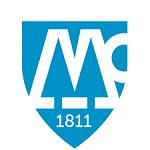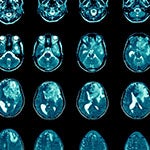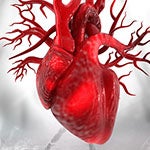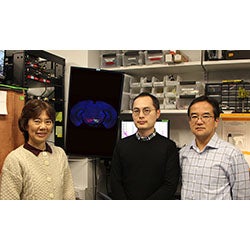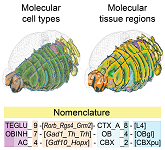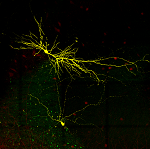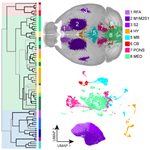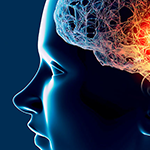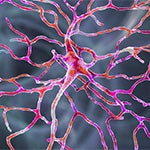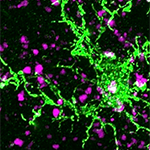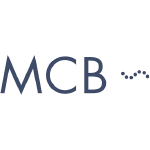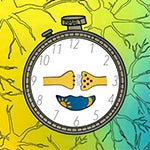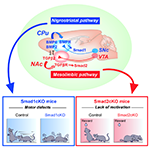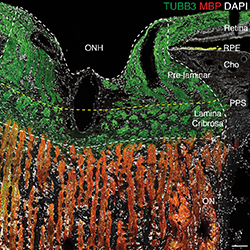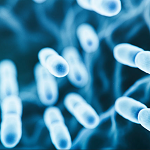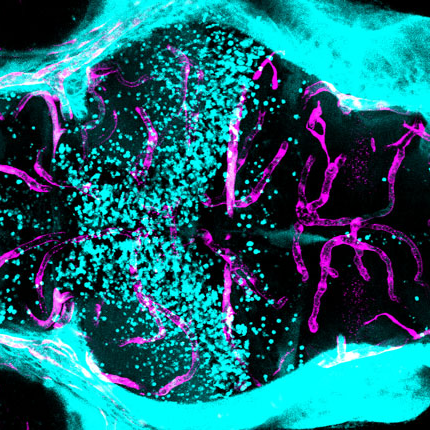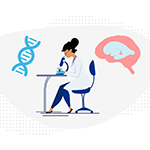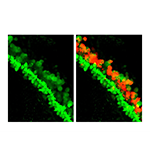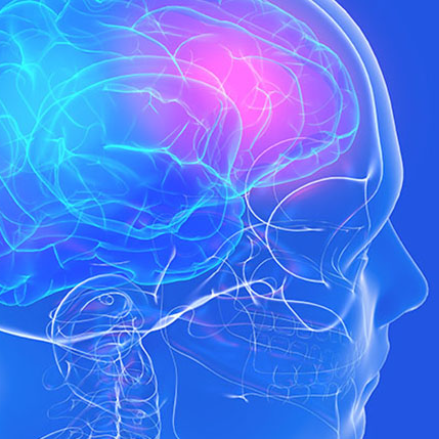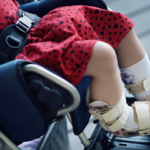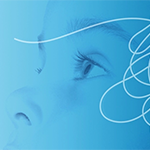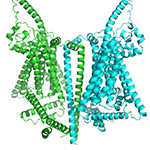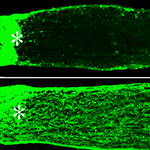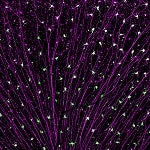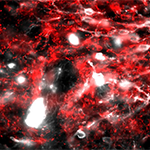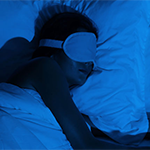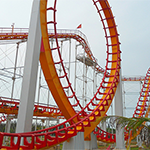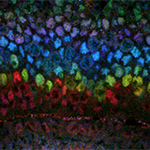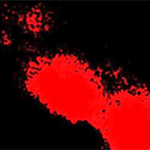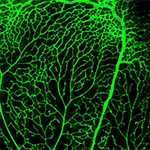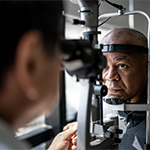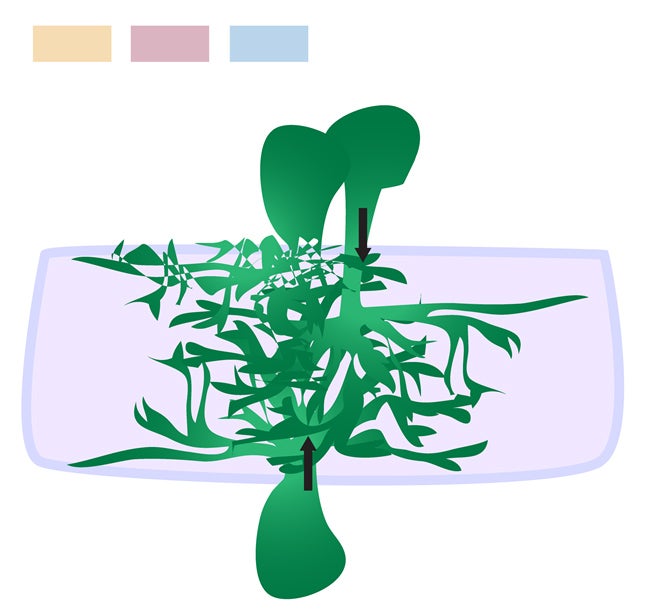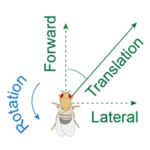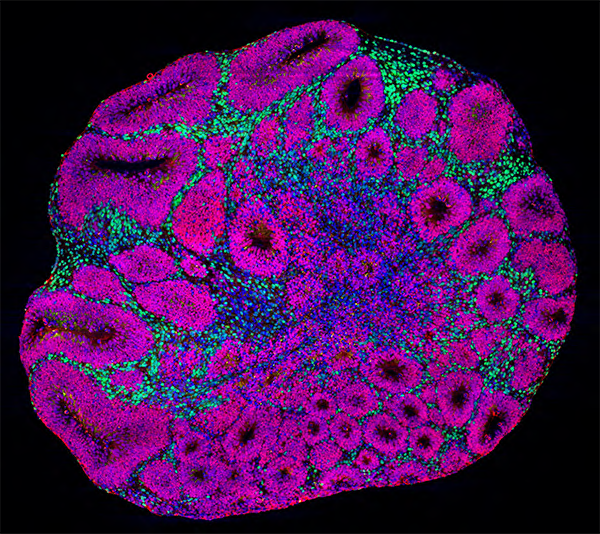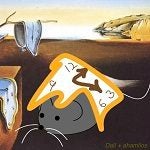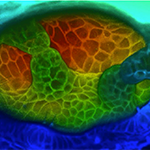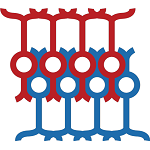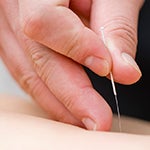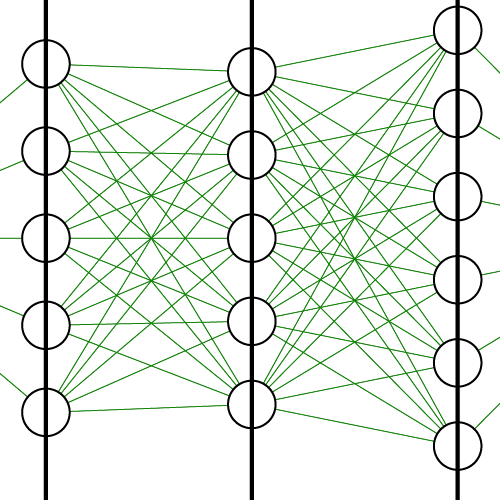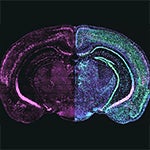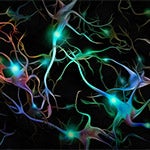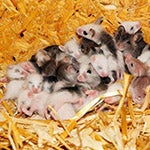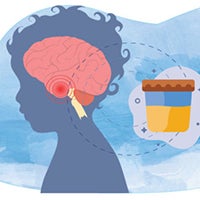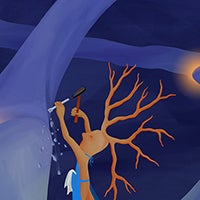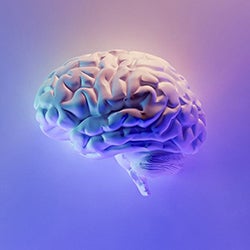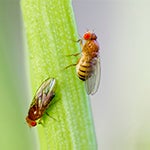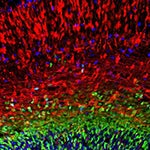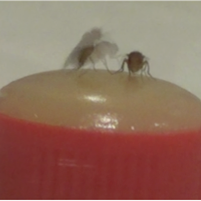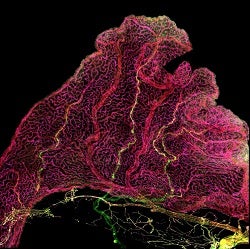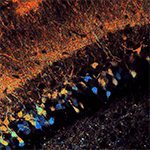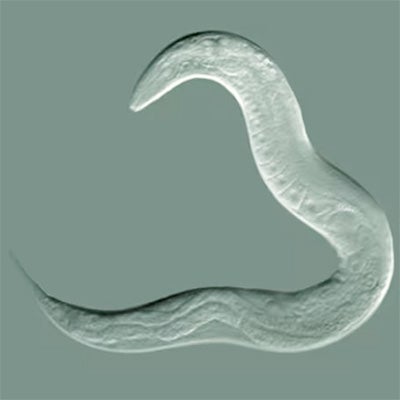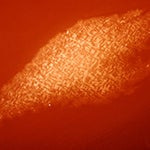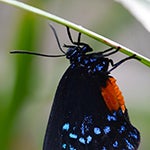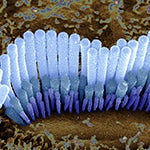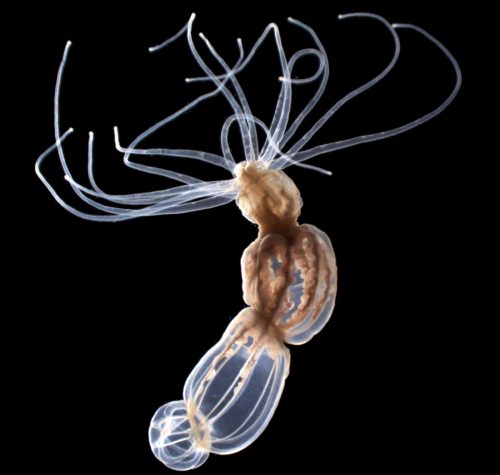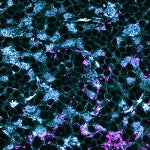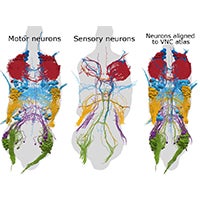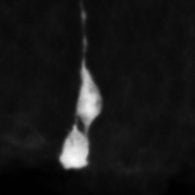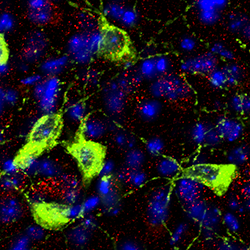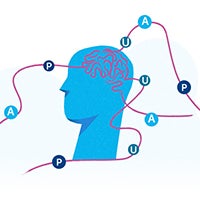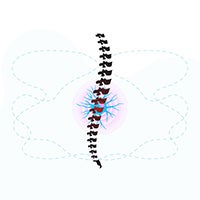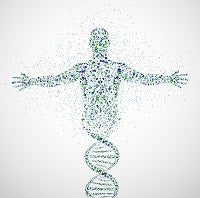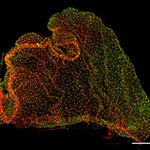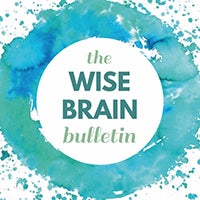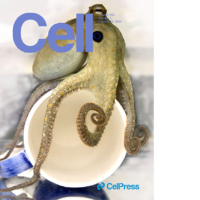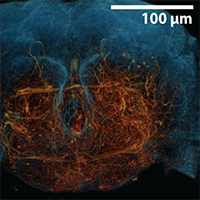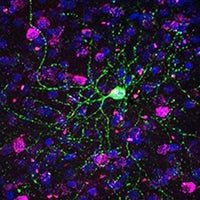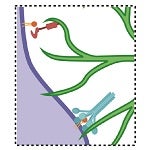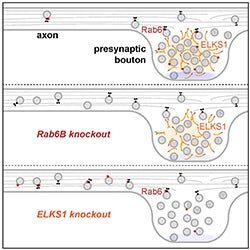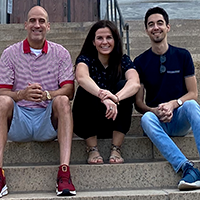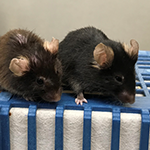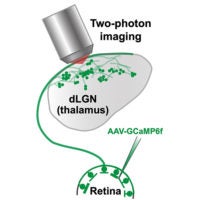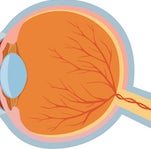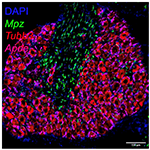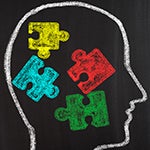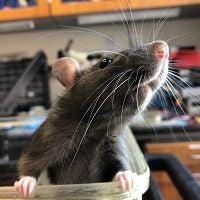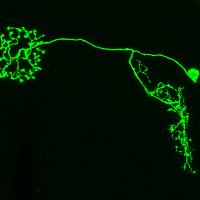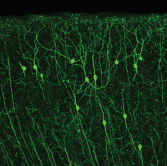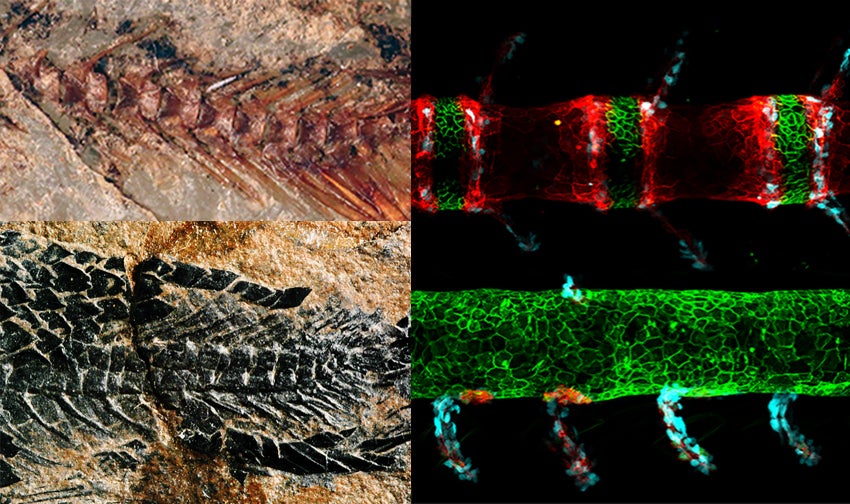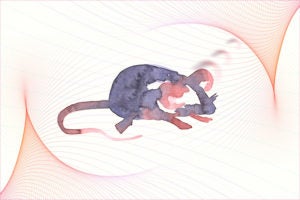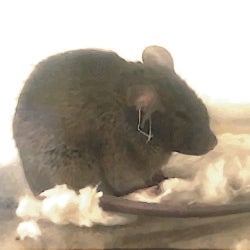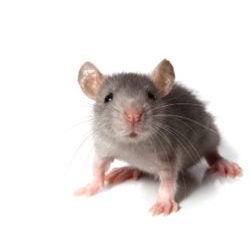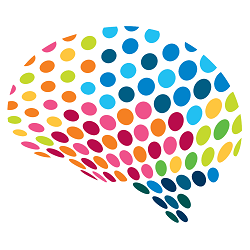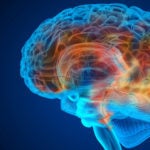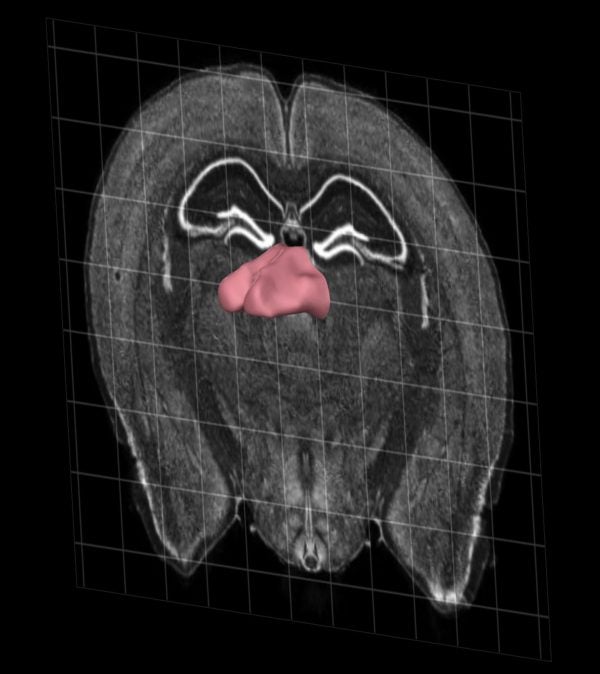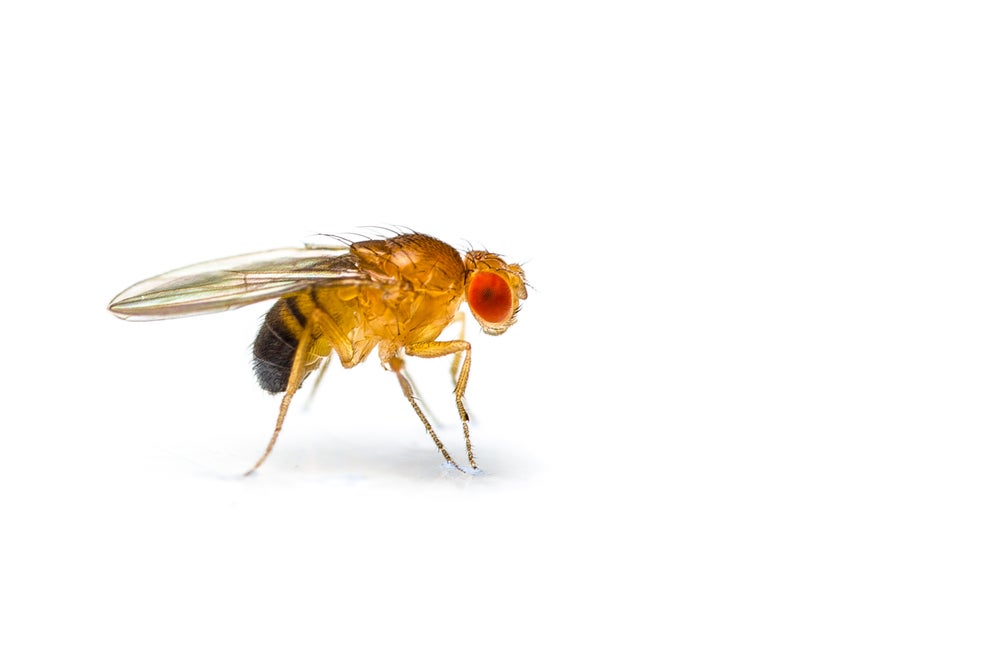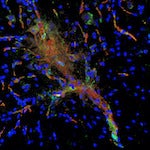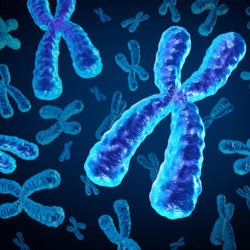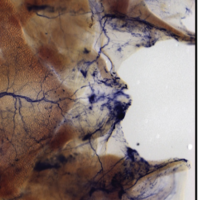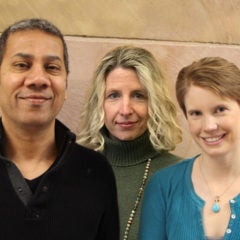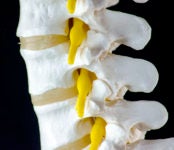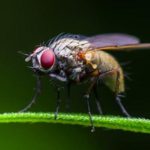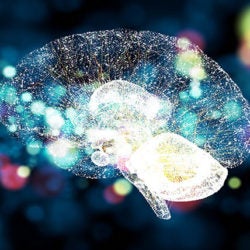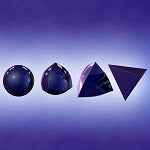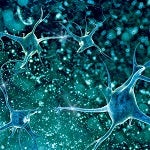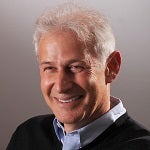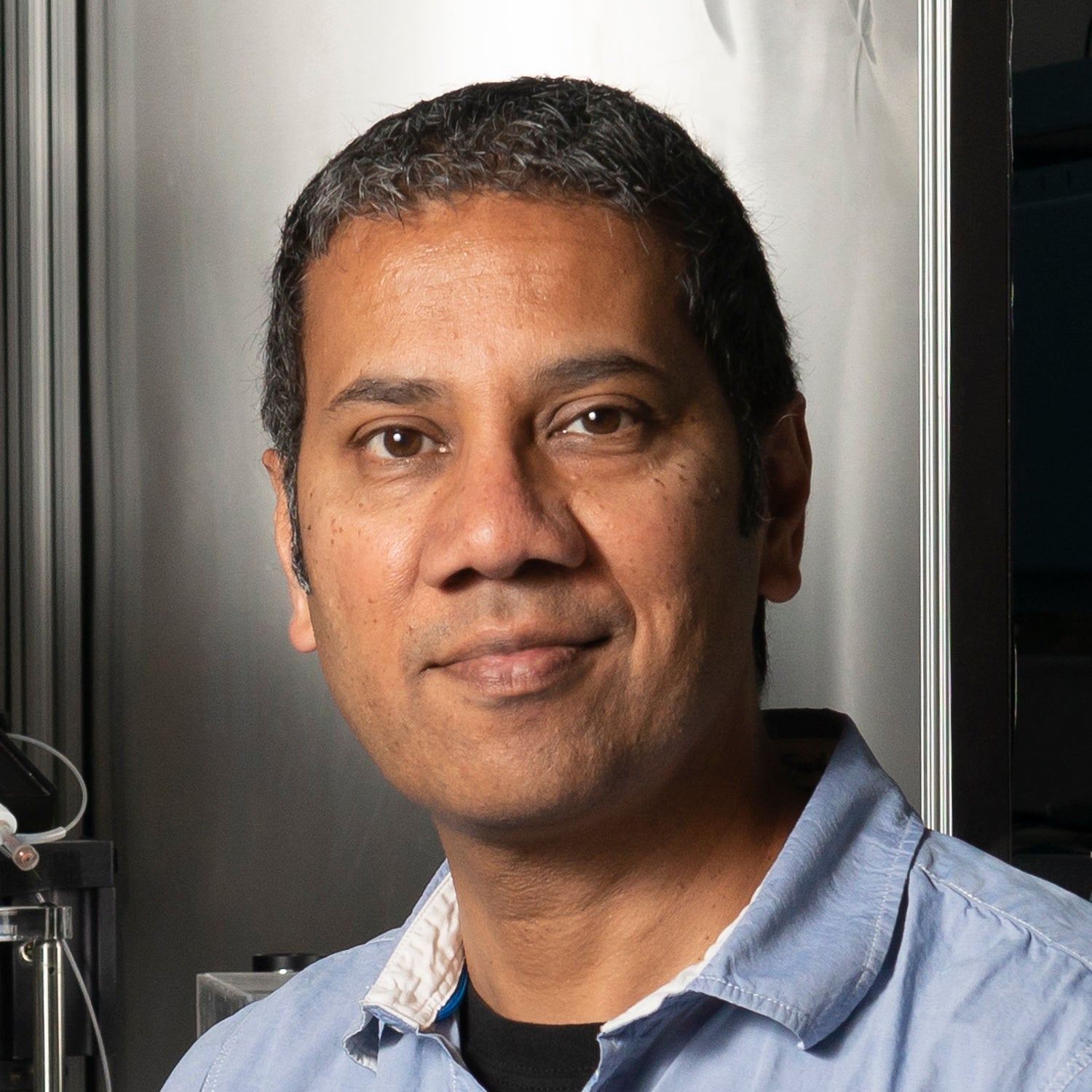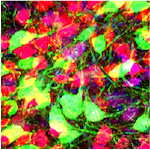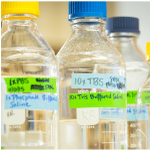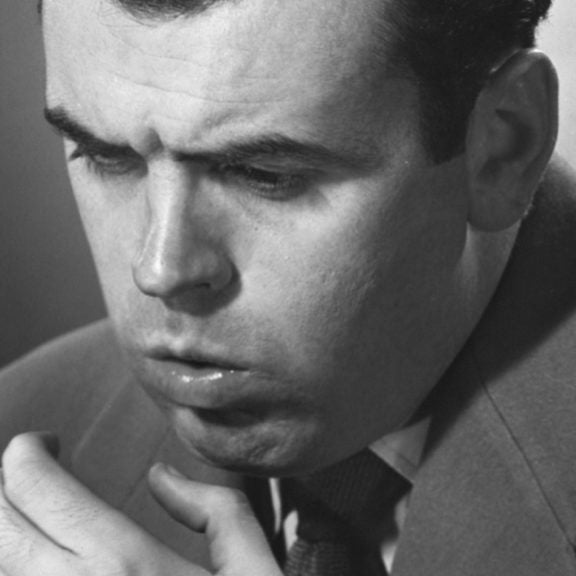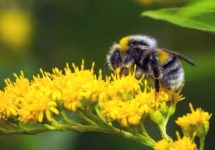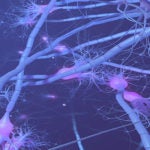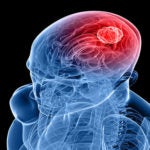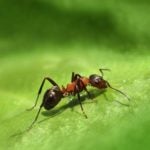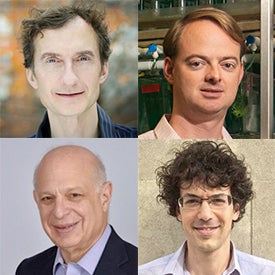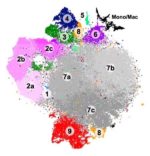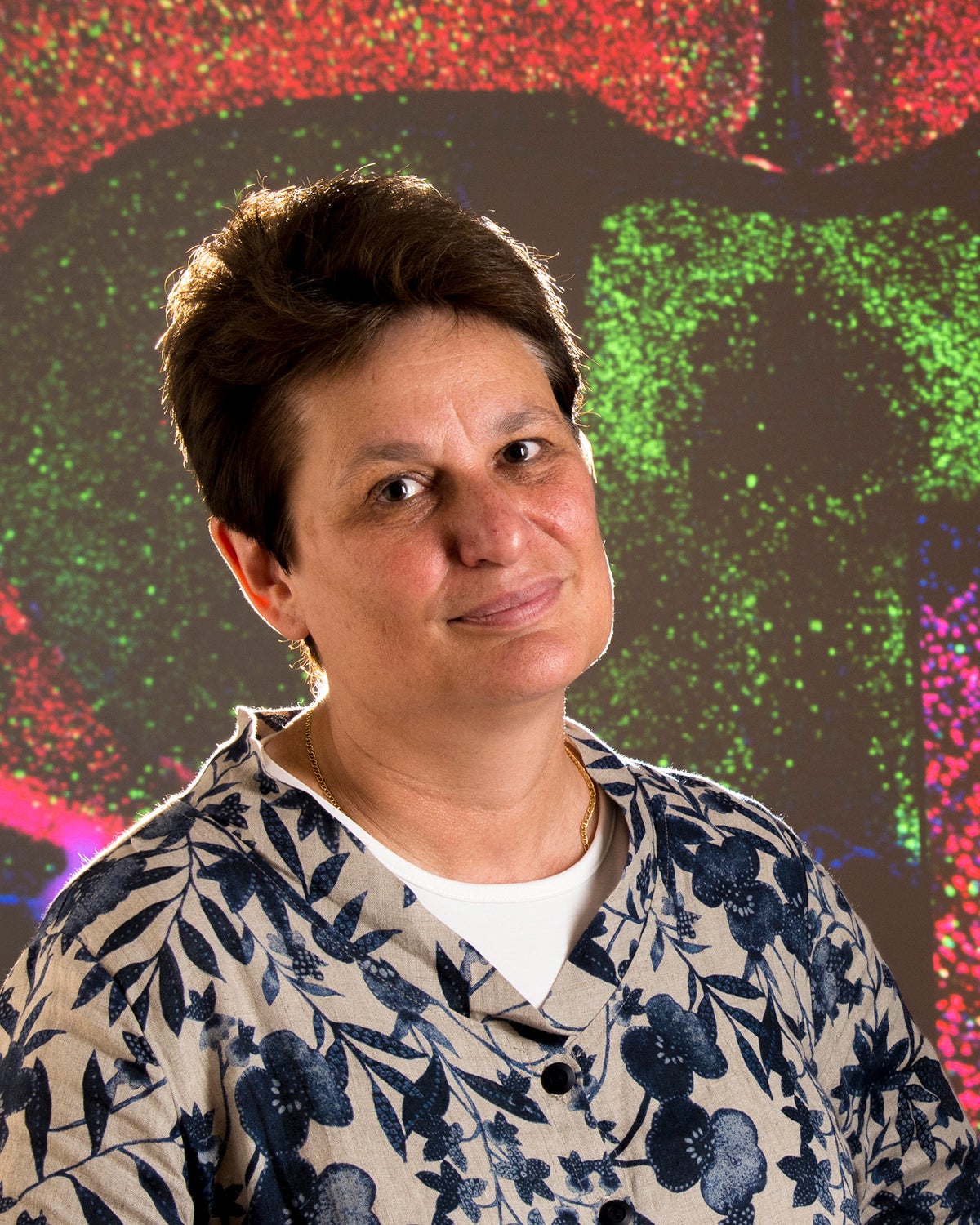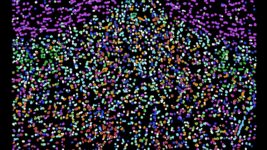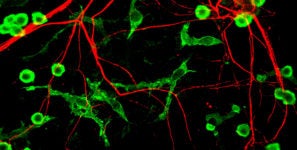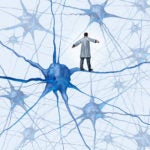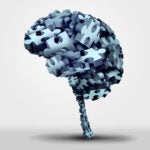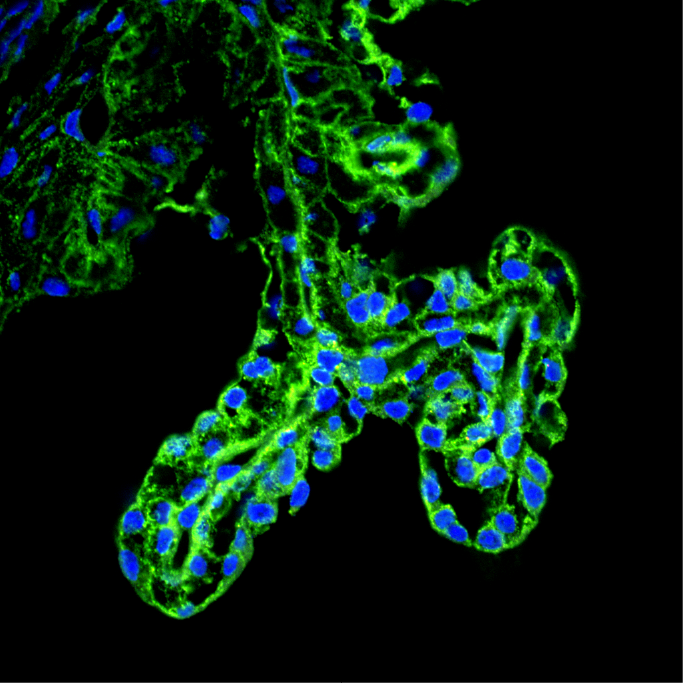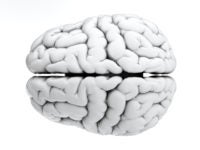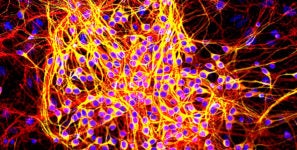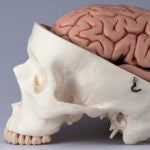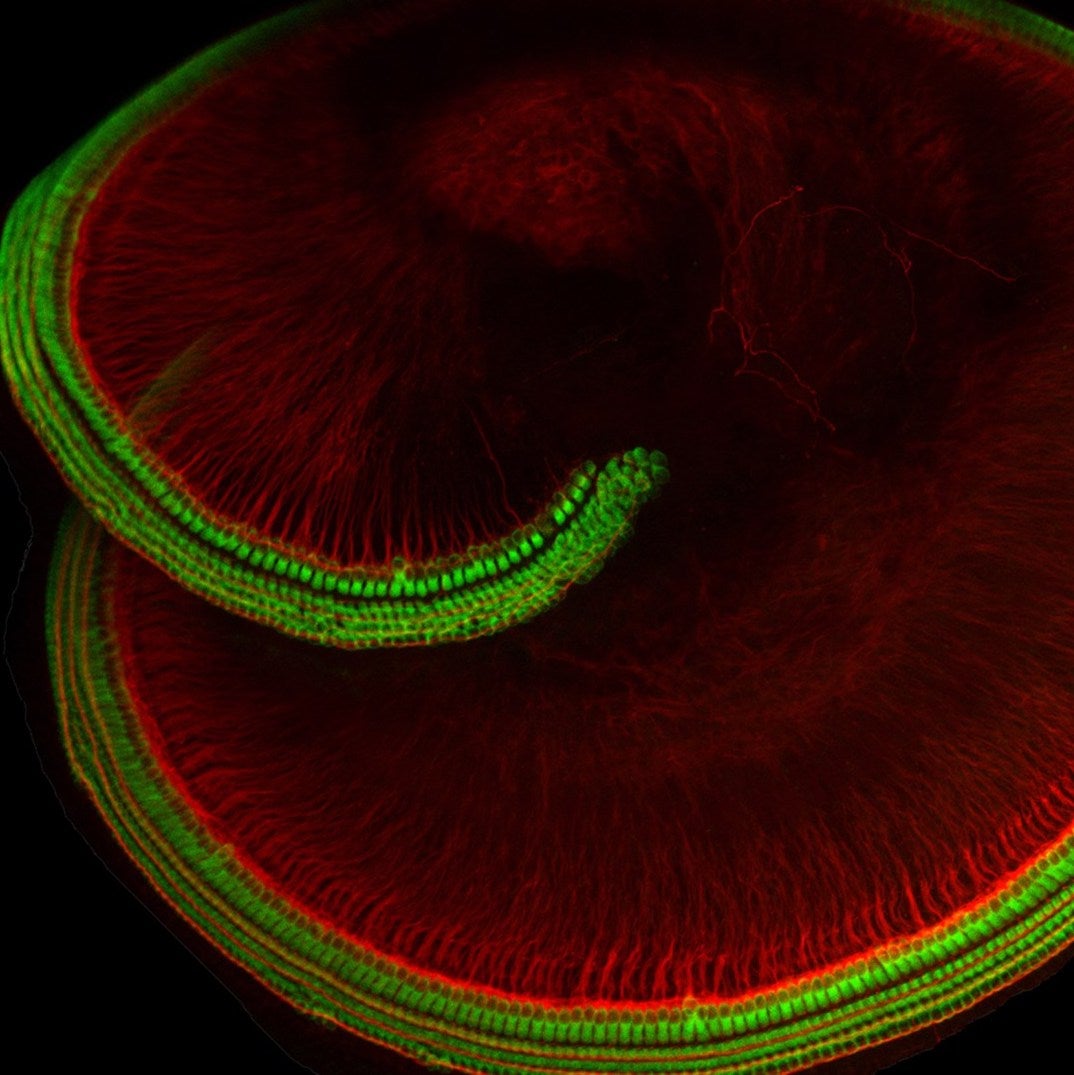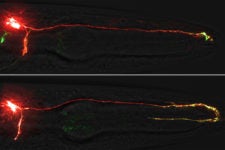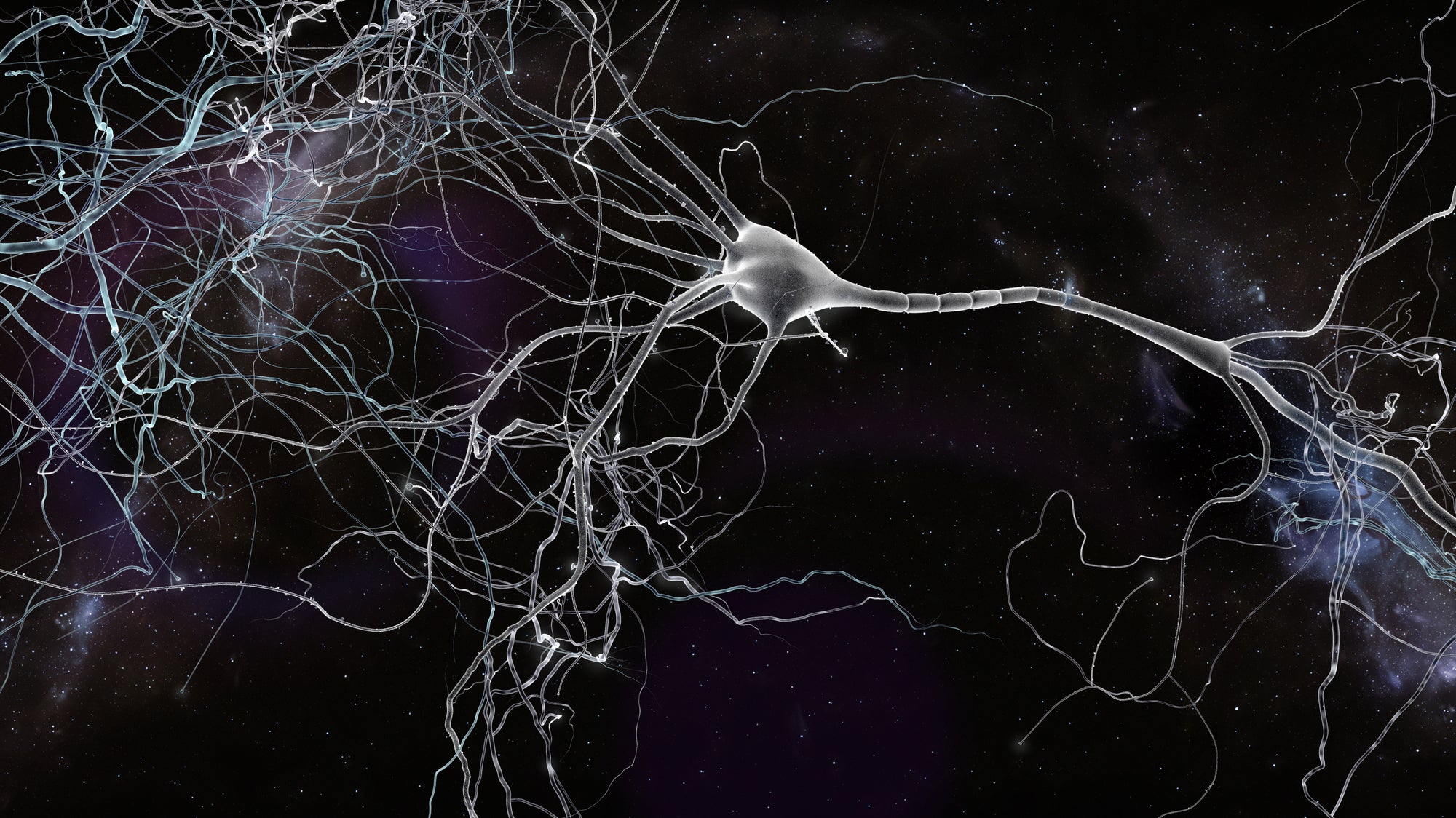Neuro Topics - Cellular and Molecular Neuroscience
SEARCH OTHER RESEARCH AREAS
April 22, 2024
A new study led by researchers at McLean Hospital and Washington State University used advances in digital testing to demonstrate that naturally occurring glucose fluctuations impact cognitive function in people with type 1 diabetes (T1D).
Original article in: NPJ Medicine >
March 27, 2024
Preliminary results of a first-in-human trial for a new CAR T-based treatment targeting two different sites on glioblastoma tumors result in dramatic, but transient, reductions in tumor size.
Original article in: New England Journal of Medicine >
February 23, 2024
From the team of Rajat M. Gupta and colleagues. Co-first authors Gavin R. Schnitzler and Helen Kang (Stanford). Featured in HMS News.
New research from Rajat M. Gupta and colleagues, co-first authors Gavin R. Schnitzler and Helen Kang (Stanford), uncover how genetic changes in cells that line blood vessels fuel cardiac disease and brain vessel malformations.
Original article in: Nature >
February 16, 2024
One cell, the “midget retinal ganglion cell,” carries the vast majority of visual information from the eye to the brain in humans. It has been thought to be a primate-specific innovation, making it impossible to study in accessible model systems. Josh Sanes shares how, using molecular comparison of retinas from 17 vertebrate species, researchers from his team and that of former postdoc Karthik Shekhar, were able to trace back through evolution and identify mouse orthologues of midget cells.
Original article in: Nature >
February 8, 2024
The Uchida lab used a genetically encoded glutamate sensor to examine the pattern of glutamate inputs to dopamine neurons in mice. Combining the results with existing knowledge about GABA signaling to these neurons, they gained a new understanding of how these two neurotransmitters collaborate to bring dopamine neurons the information they need to encode reward prediction error (RPE)—the difference between expected and received rewards.
Original article in: Neuron >
February 8, 2024
By combining retinal imaging, genetics, and big data, physician-researchers from Harvard Medical School, Mass. Eye and Ear, Massachusetts General Hospital, and the Broad Institute of MIT and Harvard have found that they can estimate how likely a person is to develop eye and systemic diseases in the future.
Original article in: Science Translational Medicine >
February 7, 2024
Yichun He and Hailing Shi share new work from labs of Jia Liu and Xiao Wang, on the creation of publicly accessible spatial atlas of the mouse brain with unprecedented level of detail—featuring an analysis of over one million individual cells that pinpointed approximately 230 unique molecular cell types and delineated 106 distinct molecular tissue regions.
Original article in: Nature >
February 6, 2024
Yu-Tzu Shih, Jason Alipio, and Amar Sahay share new research on the autism linked gene Dyrk1a. They find that developmental differences in neural circuitry and social cognition observed in mutant mice with only one copy of the Dyrk1a gene can be rescued by targeting inhibitory neuron plasticity in adulthood.
Original article in: Neuron >
February 2, 2024
The brain controls nearly all bodily functions via spinal projecting neurons that carry command signals from the brain to the spinal cord. As part of a collaborative effort by the BRAIN Initiative Cell Census Network, research co-led by the Zhigang He Lab and Allen Institute for Brain Science used whole-brain imaging and single nucleus transcriptomics to comprehensively profile the anatomy and molecular makeup of these neurons that connect the brain and the body.
Original article in: Nature >
February 2, 2024
Harvard Medical School researchers at Brigham and Women’s Hospital and the Wyss Institute have developed a molecular test that successfully detected and quantified telltale protein clumps in tissue and fluid samples obtained from patients with Parkinson’s disease.
Original article in: PNAS >
December 7, 2023
Working with mice, HMS researchers have identified a potential new strategy for replacing retinal ganglion cells to treat glaucoma, one of the leading causes of blindness worldwide. Featured in HMS News From Petr Baranov and colleagues, first author Jonathan R. Soucy.
Original article in: PNAS >
November 13, 2023
HMS News article on new research from the lab of Beth Stevens, first author Dan Wilton, showing how the process of Huntington’s disease begins well before symptoms appear — and revealing that in mice, the process can be blocked to prevent cognitive problems thought to be relevant in Huntington’s disease, studied with visual discrimination learning and cognitive flexibility tasks.
Original article in: Nature Medicine >
October 27, 2023
Harvard MCB Department news article on new research from the lab of Amanda Whipple, first author Daniel Loftus, finding that differences in maternal and paternal genomes in embryonic stem cells shape gene expression in neurons.
Original article in: Genes and Development >
October 26, 2023
The time of day influences cognition, but the molecular and synaptic mechanisms of this influence are elusive. We show that the circadian clock protein BMAL1 has a rhythm in synapses that is critical for corresponding rhythms in synaptic plasticity. Our findings point to local mechanisms for gating computations in anticipation of the time of day.
Original article in: Science Advances >
October 6, 2023
Akiko Terauchi and Hisashi Umemori share new research that identified the pathway-specific signals that establish functionally segregated dopaminergic synaptic connections in the mammalian brain. The findings may provide strategies to treat pathway-specific disease symptoms in diseases like Parkinson's disease, schizophrenia, and depression, by targeting the pathway-specific molecular signals.
Original article in: Cell >
September 13, 2023
HMS News article on new research from Mike Greenberg and colleagues, co-first authors Xin Gu and Christopher Nardone, identifying a protein called midnolin that plays a key role in degrading many short-lived nuclear proteins. The study shows that midnolin does so by directly grabbing the proteins and pulling them into the cellular waste-disposal system, called the proteasome, where they are destroyed.
Original article in: Science >
August 30, 2023
HMS News article on new research from David Ginty and colleagues, first author Rachel L. Wolfson, defining five types of colon neurons that are specialized for sending different signals to the brain. These findings may eventually lead to the development of better therapies for a variety of gastrointestinal problems.
Original article in: Cell >
August 17, 2023
Josh Sanes shares new research from his lab using single cell RNA sequencing to determine the genes expressed by thousands of single cells to complete a cell atlas of the human eye. This now allows scientists to target specific genes when treating conditions such as glaucoma and other ocular diseases.
Original article in: PNAS >
August 9, 2023
HMS News article on new research from Francisco Quintana and colleagues, first author, Liliana M. Sanmarco, designing a probiotic suppressing autoimmunity in the mouse brain, a condition that occurs when the immune system attacks the cells of the central nervous system. This technique offers a more precise way to target brain inflammation and minimizes negative side effects when compared with standard therapies.
Original article in: Nature >
July 21, 2023
HMS News article on new research from Sean Megason, Chenghua Gu, Allon M. Klein, and colleagues, first author Natasha O'Brown, using mice and zebrafish to discover a signal produced by neurons that helps the blood-brain barrier form and maintain its protective properties.
Original article in: Developmental Cell >
May 25, 2023
HMS News article on new research from Christopher A. Walsh and Kristopher T. Kahle, co-first authors Sattar Khoshkhoo and Yilan Wang, examining the role of somatic mutations — DNA alterations that occur after conception — in Temporal Lobe Epilepsy (TLE) and suggesting the potential of using existing cancer therapies to treat TLE that is resistant to anti-seizure medications.
Original article in: JAMA Neurology >
May 25, 2023
Boston Children's Hospital Answers article on new research from from the teams of Maria Lehtinen, Mark Andermann, Hanno Steen, and clinician colleagues at Boston Children’s Hospital and Mass General Hospital, co-first authors Cameron Sadegh and Huixin Xu, suggesting that gene therapy targeting the brain’s choroid plexus could help prevent or ameliorate hydrocephalus in premature newborns with brain bleeds.
Original article in: Neuron >
May 11, 2023
HMS News article on new research from David Corey, Artur A Indzhykulian, and colleagues, first author Maryna Ivanchenko. Using mice, the team designed a “mini gene” that could in the future be developed into a therapy for Usher Syndrome type 1F, a severe genetic condition that causes blindness and deafness.
Original article in: Nature Communications >
April 25, 2023
Loss of the inner ear sensory cells, the hair cells, is considered one of the most common causes of hearing loss that is generally permanent. Using single-cell RNAseq, advanced imaging, electrophysiology, and lineage tracing, Yizhou Quan, Zheng-Yi Chen, and colleagues identified a cocktail of drug-like molecules that effectively reprograms fully mature wildtype supporting cells for hair cell regeneration, representing a step forward for hearing restoration by HC regeneration.
Original article in: PNAS >
March 31, 2023
The lab of Stephen Liberles was featured in Science News for their recent paper illuminating how the brain becomes aware that there is an infection in the body.
Original article in: Nature >
March 9, 2023
HMS News article on new research from Isaac Chiu and colleagues, first author Felipe Pinho-Ribeiro, showing that bacteria hijack crosstalk between nerve and immune cells to cause meningitis.
Original article in: Nature >
March 9, 2023
Boston Children's Hospital Answers article on new research from Siddharth Srivastava, Annapurna Poduri, and colleagues confirming a previous study finding that about 1 in 4 children with cerebral palsy (CP) who had DNA testing had genetic variants likely to have caused or contributed to their condition.
Original article in: JAMA Neurology >
February 23, 2023
In order for neurons to be ‘plastic’ and adapt in response to environmental stimuli, they must undergo rapid changes in gene expression. Sometimes these rapid changes can lead to DNA damage. Daniel Gilliam and Elizabeth Pollina of the Greenberg lab describe their discovery of a DNA repair pathway that neurons use to address this challenge.
Original article in: Nature >
January 25, 2023
HMS News article on new research from Sandeep Robert Datta, David Brann, Tatsuya Tsukahara, and colleagues at Duke Health and UC San Diego, finding that long-term loss of smell may be linked to an ongoing immune assault on olfactory nerve cells and an associated decline in the number of those cells.
Original article in: Science Translational Medicine >
January 25, 2023
HMS News article on new research from Khalid Shah and colleagues, first author Kok-Siong Chen, on the development of a new cell therapy approach engineered to eliminate established tumors and to train the immune system to prevent cancer recurrence.
Original article in: Science Translational Medicine >
October 14, 2022
Boston Children's Hospital Answers article on new research from Maria Lehtninen, Naama Kanarek, and colleagues, first author Ahram Jang, on the feasibility of targeting the cerebrospinal fluid and choroid plexus to treat "chemo-brain"-- a side effect of chemotherapy that makes it harder to remember things, maintain attention, and learn new information.
Original article in: Neuron >
October 14, 2022
HMS News article on new research from Frank Scheer and colleagues, first author Nina Vujović, providing experimental evidence that late eating may increase hunger and obesity risk.
Original article in: Cell Metabolism >
Exploring the Molecular Dynamics of Hearing: Ion Channels That Convert Sound into Electrical Signals
October 5, 2022
Nurunisa Akyuz of the Corey lab describes a new study focused on the inner-ear mechanosensory channel, TMC1 (Transmembrane Channel Like 1). Structural modeling, mutagenesis, viral gene delivery and hair-cell physiology experiments were used to determine aspects of TMC1 gating.
Original article in: Science Advances >
September 29, 2022
Boston Children's Hospital Answers article on new research from Joseph Gonzalez-Heydrich, David Glahn, and colleagues, co-first authors Catherine Brownstein and Elise Douard (Université de Montréal) finding that children with early-onset psychosis have similar rates of deleterious copy number variants (CNVs) as children diagnosed with autism spectrum disorder. The new study suggests that all children and adolescents with a psychotic diagnosis might benefit from undergoing genetic screening.
Original article in: American Journal of Psychiatry >
September 20, 2022
HMS News article on new research from the labs of Christopher Harvey and Michael Greenberg, first author Noah Pettit, and second author Lynn Yap, finding that a gene called Fos is a key player in spatial mapping. It helps the brain use specialized navigation cells to form and maintain stable representations of the environment.
Original article in: Nature >
September 16, 2022
Yuqin Yin and Larry Benowitz describe a new study using RNA sequencing and bioinformatics to identify the transcription factor REST (a.k.a. NRSF) as a key repressor of the genetic program required for neurons to regenerate axons in the central nervous system. Counteracting the inhibitory effects of REST enhances the ability of retinal ganglion cells to regenerate axons through the injured optic nerve and of cortical neurons to regenerate axons in the corticospinal tract.
Original article in: Nature Communications >
July 22, 2022
Neurons called retinal ganglion cells (RGCs) send axons from the retina to the rest of the brain through the optic nerve. When the optic nerve is crushed, most RGCs die and few if any survivors regrow new axons. The labs of Josh Sanes (Harvard) and Zhigang He (Boston Children’s Hospital) recently published two papers defining gene expression programs that regulate RGC survival and regeneration.
Original article in: Neuron >
June 30, 2022
HMS News profiling PiNBAC, a new post-bac program that seeks to increase diversity in neuroscience by providing research experience and professional development to college graduates from underrepresented groups. PiNBAC is led by Tari Tan and Bob Datta of the Dept of Neurobiology at HMS.
Original article in: Neuron >
June 30, 2022
HMS News article on new research from Stephen Liberles and colleagues, first author Chuchu Zhang, using mice to describe how different cell types in the brain work together to suppress nausea.
Original article in: Cell Reports >
June 15, 2022
Harvard Dept. of MCB News article on new research from Catherine Dulac and colleagues, first author Jessica Osterhout, showing how neurons in the brain directly read signals from the body’s immune system and how those signals alter neural circuit activity to trigger symptoms of sickness.
Original article in: Nature >
June 15, 2022
Harvard Gazette article on new research from Charles Czeisler and colleagues, first author Jeanne F Duffy, showing that administering a 5 mg dose of melatonin increased total sleep time compared to a placebo in a small group of healthy adults aged 55 and older.
Original article in: The Journal of Pineal Research >
May 24, 2022
HMS News article on new research from Christopher J. Hartnick and colleagues, first author Phoebe K. Yu, demonstrating that a surgically implanted device that moves the tongue forward during sleep can safely and effectively reduce sleep apnea in adolescents with Down syndrome.
Original article in: Nature Communications >
May 24, 2022
HMS News profile on Josefina del Marmol, a newly hired assistant professor of biological chemistry and molecular pharmacology, who studies how animals detect and identify scents.
Original article in: Nature Communications >
May 24, 2022
Harvard Health Publishing article outlining LATE (limbic-predominant age-related TDP-43 encephalopathy), the third most common cause of dementia in older individuals.
Original article in: Nature Communications >
May 24, 2022
Round up of awards and honors earned by the HBI community.
Original article in: Nature Communications >
May 4, 2022
Harvard Gazette article on new research from Yun Zhang and colleagues, co-first authors He Liu and Taihong Wu, showing that forgetting generates a novel brain state that is different from the one before learning happened or the one that exists after a memory is formed.
Original article in: Science Advances >
May 4, 2022
Harvard Gazette article on new research from Michael A. Lodato, Eunjung Alice Lee, Christopher A. Walsh, Michael B. Miller, and colleagues, demonstrating that somatic mutations accumulated in the brain cells of patients with Alzheimer’s disease at a faster rate, potentially explaining why brain cells die and revealing new pathways to target for treatment.
Original article in: Nature >
May 4, 2022
HMS News article on new research from Benjamin Neale and colleagues at the Broad Institute, first author Duncan Palmer, revealing new insight into the condition’s molecular underpinnings.
Original article in: Nature Genetics >
May 4, 2022
HMS News article from Claude Desplan (NYU) and colleagues, co-first authors Nikolaos Konstantinides, Isabel Holguera, and Anthony M. Rossi, on new research uncovering factors that regulate neuron development in fruit fly visual system.
Original article in: Nature >
May 4, 2022
HMS News article on new research from Pascal Kaeser and colleagues, first author Changliang Liu, identifying a new mechanism that underlies dopamine release in the brain.
Original article in: Science >
April 21, 2022
HMS News article on new research from the lab of Chenghua Gu, first author Swathi Ayloo, identifying a new mechanism regulating the permeability of the blood-brain barrier in mice.
Original article in: Neuron >
April 21, 2022
Harvard Health Publishing article discussing recent research suggesting that cataract surgery may protect against dementia.
Original article in: Neuron >
April 21, 2022
Round-up of awards and honors earned by the HBI community.
Original article in: Neuron >
March 31, 2022
When neural circuits are assembled, several asymmetric cell behaviors are involved. How are these behaviors coordinated? Evelyn Avilés from the lab of Lisa Goodrich discusses how a new study of the molecule Fat3 and its interactors give us some answers.
Original article in: Cell Reports >
March 9, 2022
Jenny Lu and colleagues in Rachel Wilson’s lab share new work on a neural circuit in the fly that transforms velocity from body-centric to world-centric reference frames. This work reveals how vector computations can be performed in the brain.
Original article in: Cell Reports >
March 8, 2022
HMS News article on a new report on depression commissioned by the Lancet and World Psychiatric Association. The report included recommendations for how health care practitioners, policymakers, community members, and people with depression can work together to build sustainable solutions in response to the ongoing mental health crises caused by the COVID-19 pandemic.
Original article in: Cell Reports >
March 8, 2022
Erin Hecht answers this question as part of Harvard Gazette's Wondering, a new series of random questions answered by Harvard experts.
Original article in: Cell Reports >
March 8, 2022
Bruna Paulsen shares new research from the labs of Paola Arlotta and colleagues, using organoid models of the human cerebral cortex to uncover cell-type-specific neurodevelopmental abnormalities that are shared across three different ASD risk genes.
Original article in: Cell Reports >
February 25, 2022
Allison E. Hamilos from the lab of John Assad shares new insights into the role of dopaminergic signaling in modulating the moment-to-moment probability of planned movement.
Original article in: eLife >
February 24, 2022
Harvard Gazette article on a recent panel sponsored by the Harvard Mind Brain Behavior Initiative featuring Kirk R. Daffner, Daniel L. Schacter, and Susanna C. Siegel using the plot of the film Memento to discuss memory, amnesia, and personality.
Original article in: eLife >
February 7, 2022
HMS News article on new research from Siddharth Srivastava, Annapurna Poduri, Mustafa Sahin, and colleagues, first author Maya Chopra, finding that up to 1 in 4 patients with CP have an underlying genetic condition.
Original article in: Annals of Clinical and Translational Neurology >
February 3, 2022
Seul Ah Kim from the lab of Bernardo Sabatini shares a new method for studying multi-transmitting neurons (neurons which use more than one neurotransmitter) and explains new findings demonstrating that glutamate and GABA are co-packaged in individual synaptic vesicles in the central nervous system. This work highlights co-release of opposing transmitters leading to correlated excitatory and inhibitory signals in the lateral habenula, a brain region implicated in psychiatric disorders.
Original article in: Neuron >
January 21, 2022
Round up of awards and honors earned by the HBI community.
Original article in: Neuron >
January 21, 2022
HMS News article on a new discovery by Sean Megason and colleagues, first author Akankshi Munjal, of mechanical process by which sheets of cells morph into the delicate, looping semicircular canals of the inner ear.
Original article in: Cell >
January 21, 2022
HMS News article on new research from Isaac Chiu and colleagues, first author Nicole Yang, suggesting that anthrax has an unexpected benefit— one specific type of anthrax toxin can silence multiple types of pain in animals.
Original article in: Nature Neuroscience >
January 21, 2022
HMS News Q+A with Jan Drugowitsch about his lab's research on how the brain processes information in order to make split-second decisions, the role of computation, and the importance of collaboration in unraveling the mysteries of decision-making.
Original article in: Nature Neuroscience >
January 21, 2022
Harvard Gazette conversation with David Silbersweig on the neuroscience behind why certain songs get stuck in our heads more than others.
Original article in: Nature Neuroscience >
January 18, 2022
The Tan-Yang Center seeks a Program Manager who will be responsible for planning scientific events and outreach activities, running a postdoctoral fellowship program, managing a website, newsletter, and social media, developing new community-building activities, and liaising with the related scientific and administrative units at Harvard University, as well as our sister Center at the McGovern Institute at MIT.
Original article in: Nature Neuroscience >
November 12, 2021
HMS News article on new research from Qiufu Ma and colleagues, co-first authors Shenbin Liu and Zhifu Wang, elucidating the underlying neuroanatomy of acupuncture that activates a specific signaling pathway.
Original article in: Nature >
November 10, 2021
Luis Hernandez-Nunez shares new research conducted as a part of his PhD research in the lab of Aravinthan Samuel uncovering new molecular receptors, cells, circuits and behavioral strategies that underlie the thermosensitivity of fly larvae.
Original article in: Science Advances >
November 6, 2021
Abdulkadir Canatar, Blake Bordelon and Cengiz Pehlevan share new research exploring why neural networks do not overfit.
Original article in: Science Advances >
November 2, 2021
Sarah Melzer from the Sabatini lab shares new work on the functions of the neuropeptide GRP in regulating fear memories. Their work highlights the mechanisms through which GRP modulates a specialized neuronal circuit in the cortex during fear conditioning.
Original article in: Cell >
September 29, 2021
HMS News article on new research from the labs of Gord Fishell and colleagues, first author Kathryn Allaway, revealing how two key cell types in the brain’s cortex arise from a single progenitor in mice, as well as shedding light on genetic and molecular factors that allow these two populations to develop different identities.
Original article in: Nature >
September 1, 2021
Massachusetts General Hospital News article on new research from the labs of Christiane Wrann, Rudolph Tanzi, and Bruce Spiegelman, co-first authors Mohammad Islam and Sophia Valaris, demonstrating for the first time that irisin, the cleaved and circulating form of the exercise-induced membrane protein FNDC5, is sufficient to confer the benefits of exercise on cognitive function.
Original article in: Nature Metabolism >
August 30, 2021
Beth Israel Deaconess Medical Center press release on new research from the lab of Mark Andermann, first author Stephen X. Zhang, uncovering the precise hypothalamic neurons that regulate the drive to engage in mating behaviors in mice.
Original article in: Nature >
August 25, 2021
Graduate student Ya'el Courtney (lab of Maria Lehtinen, Boston Children's Hospital) shares her story about navigating a difficult adolescence, facing financial challenges, and her journey to graduate school and neuroscience research.
Original article in: Nature >
August 11, 2021
Boston Children's Hospital Answers article on new research from Christopher A. Walsh and colleagues, first author Richard Smith, linking mutations in the gene ATP1A3 to polymicrogyria, a disease causing irregular folds and disorganized layering in the cortex, often resulting in severe developmental and intellectual disabilities.
Original article in: PNAS >
August 11, 2021
Boston Children's Hospital Answers article on new research from Edward Smith and colleagues, first author Julie Sesen, showing that the levels of a specific protein detected through a patient’s urine can track a tumor’s size and responsiveness to treatment in children with diffuse intrinsic pontine gliomas (DIPG).
Original article in: Brain Research >
August 11, 2021
MGH Press Release on new research from from Natalia Rost and colleagues, first author Anna Katharina Bonkhoff, demonstrating that brain lesions in regions subserving motor and language functions help explain stroke severity in both men and women, however more widespread lesion patterns are relevant in female patients.
Original article in: Nature Communications >
July 29, 2021
Round up of awards and honors earned by the HBI community.
Original article in: Nature Communications >
July 29, 2021
HMS News article on new research from the labs of Gordon Fishell, Beth Stevens, Sandeep Robert Datta, and colleagues, first author Emilia Favuzzi, identifying the immune cells that sculpt inhibitory neurons and regulate brain wiring.
Original article in: Cell >
July 29, 2021
Harvard Gazette article on new research from Filip Swirski, Rudolph Tanzi, and colleagues, first author Cameron McAlpine, suggesting that Interleukin-3 from astrocytes may reprogram immune responses in the brain that cause cell death and lead to dementia.
Original article in: Nature >
Disease Characteristics of Dopaminergic Neurons in Neurodevelopmental and Neuropsychiatric Disorders
July 20, 2021
Maria Sundberg shares new research from the lab of Mustafa Sahin on the role of a small piece of chromosome 16, called the 16p11.2 locus, in disease phenotypes of dopaminergic neurons. The team identified that RhoA pathway activation led to network dysfunction in 16p11.2 deletion neurons. Its inhibitor, Rhosin, rescued the hyperactivity of these neuronal networks. In the future, the RhoA pathway and its inhibitors may serve as potential therapeutic targets.
Original article in: Nature Communications >
July 13, 2021
Ken Tao and Brad Lowell share a new study characterizing vagal motor neurons that innervate the digestive system. This work demonstrates a labeled-line model of the vagus motor nerve where genetically-defined subtypes of vagal motor neurons project to specific regions of the digestive system and engage neurochemically-distinct subtypes of enteric neurons.
Original article in: Neuron >
July 9, 2021
Stephen Zhang shares new research from the labs of Mike Crickmore and Dragana Rogulja showing that young male flies have functional courtship circuitry, but the motivation to mate is suppressed by a hormone until maturity.
Original article in: Science Advances >
July 7, 2021
Harvard Gazette article on new research from the lab of Paola Arlotta and colleagues at the Broad Institute, co-first authors Daniela Di Bella and Ehsan Habibi, combining single-cell genomic technologies to create an atlas for studying cellular diversification in the developing mouse cortex.
Original article in: Nature >
July 7, 2021
Harvard Gazette article announcing the founding of the Center for the Neuroscience of Psychedelics at Massachusetts General Hospital, to be led by Jerrold Rosenbaum.
Original article in: Nature >
June 21, 2021
Lili Xie shares new research from the lab of Larry Benowitz showing that the chemokine CCL5 promotes optic nerve regeneration and mediates many of the beneficial effects of Ciliary neurotrophic factor (CNTF) gene therapy.
Original article in: PNAS >
June 11, 2021
HMS News article on new research from Rudolph Tanzi and colleagues, first author Raja Bhattacharyya, discovering how amyloid beta—the neurotoxin believed to be at the root of Alzheimer’s disease—forms in axons and related structures that connect neurons in the brain, where it causes the most damage.
Original article in: Cell Reports >
June 11, 2021
Round up of awards and honors earned by the HBI community.
Original article in: Cell Reports >
June 4, 2021
Rachel Monyak and Edward Kravitz share new research characterizing a line of masculinized female flies that switches its style of fighting based on the sex of its opponent. This work furthers our understanding of factors that initiate fighting and offers clues as to why flies use male or female aggressive strategies.
Original article in: Journal of Experimental Biology >
June 4, 2021
Harvard Gazette article on new research from Rakesh K. Jain and colleagues, co-first authors Zohreh Amoozgar, Jonas Kloepper, and Jun Ren, retraining tumor-promoting immune cells to fight most aggressive type of brain cancer.
Original article in: Nature Communications >
May 17, 2021
Neil Dani & Maria Lehtinen share new research done with Rebecca Herbst, Naomi Habib & Aviv Regev at the Broad Institute. Using single cell & nucleus sequencing, coupled with tissue-level mapping, they have generated the first cellular and spatial atlas of the choroid plexus blood-CSF barrier. This addresses a historical blind spot by characterizing the core cell types, subtypes, their spatial organization and diversity across brain regions of the developing, adult, and aging mouse brain.
Original article in: Cell >
May 6, 2021
Erin Johnson-Venkatesh and Hisashi Umemori share their work trying to understand why X-linked PCDH19-related disorder occurs only in females, and not males – when the opposite is typical for most disorders emanating from mutations on the X-chromosome. They find that inactivation of one copy of Pcdh19 results in a molecular mismatch at hippocampal synapses, leading to functional impairments in female, but not male mice.
Original article in: Science >
May 4, 2021
HMS News article on new research from Jochen Lennerz and colleagues uncovering the molecular and cellular mechanisms behind cold-induced tooth pain and hypersensitivity.
Original article in: Science Advances >
May 4, 2021
HMS News article on new research from Stephen Liberles and Nao Horio into the neurobiology that underlies food attraction and how hungry mice choose to pay attention to one object in their environment over another.
Original article in: Nature >
April 29, 2021
Carlos Manlio Díaz-García and Gary Yellen share new research on how neurons cope with moment-to-moment energy demands during bouts of intense activity. Precise coordination of energy production with brain activity is crucial for healthy brain function.
Original article in: eLife >
April 23, 2021
Harvard Gazette article on new research from the lab of Christina Woo, first author Yun Ge, on the development of a new highly-selective tool to study proteins through the sugars they depend on.
Original article in: Nature Chemical Biology >
April 23, 2021
HMS News article highlighting a new project from Max Heiman, Keith Blackwell, and Monica Colaiácovo, looking into why some species of wild Caenorhabditis elegans are able to thrive in in high temperature environments.
Original article in: Nature Chemical Biology >
April 23, 2021
HMS News article on new research from K. Frank Austen and Isaac Chiu, first author Tiphaine Voisin, suggesting that cysteine leukotriene receptor 2 (CysLT2R) may be a new target for designing treatments to target intractable chronic itch.
Original article in: PNAS >
April 23, 2021
HMS News article on new research from the lab of Connie Cepko, first author Yunlu Xue, marking an important first step in developing a gene therapy to treat retinitis pigmentosa, or RP, an inherited form of progressive blindness that affects around 20 million people worldwide.
Original article in: eLife >
April 8, 2021
Harvard Catalyst interview with Paulo Lizano, a neuropsychiatrist and assistant professor of psychiatry at Beth Israel Deaconess Medical Center (BIDMC) and Harvard Medical School.
Original article in: eLife >
April 8, 2021
Harvard Gazette article on new research from Ya-Chieh Hsu, Amar Sahay, and colleagues, first author Sekyu Choi, identifying the biological mechanism by which chronic stress impairs hair follicle stem cells, confirming long-standing observations that stress might lead to hair loss.
Original article in: Nature >
April 8, 2021
Harvard Gazette article on new research from Bradley Hyman and colleagues, co-first authors Susanne Wegmann and Sarah L. DeVos, applying a genetic engineering strategy to dramatically reduce levels of tau — a key protein that accumulates and becomes tangled in the brain during the development of Alzheimer’s disease — in an animal model of the condition.
Original article in: Science Advances >
March 26, 2021
Jing Peng and Ivan Santiago share new research revealing a temporally precise transcriptional cascade that orchestrates the assembly of synaptic layers in the fly visual system. This story is a special piece honoring the memory of their mentor Matt Pecot, who sadly passed away in 2019, with words of remembrance in addition to the scientific update.
Original article in: PNAS >
March 23, 2021
Harvard Gazette article on new research from Min Dong, David Liu, and colleagues, first author Travis Blum, on the potential of botulinum toxin therapies to aid in neuroregeneration, regulating growth hormones, calming rampant inflammation, or dampening cytokine storms.
Original article in: Science >
March 19, 2021
Katrin Vogt shares new research from the lab of Aravi Samuel identifying how feeding state-dependent neuronal modulations affect processing of olfactory information and olfactory choice behavior in Drosophila larvae.
Original article in: Science Advances >
March 9, 2021
Harvard Gazette article on new research from Naomi Pierce and colleagues, first author Marjorie A. Liénard, describing a novel method for isolating opsins, light-sensitive proteins found in the eyes of insects, and detailing their molecular history, structure, and function to determine what colors an insect can see.
Original article in: PNAS >
February 26, 2021
HMS News article on research from the labs of David Corey and Wesley Wong, first author Eric Mulhall, providing new insight into the functioning of the tip link—the tiny apparatus of hair cells in the ear that converts auditory signals into electrical ones.
Original article in: Nature Communications >
February 26, 2021
Harvard Gazette article on research probing the molecular basis for the stinging response in sea anemones and jellyfish, and identifying how these organisms detect and filter cues from the environment when making the decision to sting or not sting. From the labs of Nicholas Bellono, Amy Lee and colleagues, first author Keiko Weir.
Original article in: Nature Communications >
February 26, 2021
MCB News article highlighting recent radio show and podcast interviews featuring HBI co-director Venkatesh Murthy, discussing the neuroscience of olfaction.
Original article in: Nature Communications >
February 26, 2021
Harvard Gazette article on new research from the MGH Center for Genomic Medicine, from the team of Marta Garaulet, Richa Saxena and colleagues, co-first authors Hassan S. Dashti and Iyas Daghla, demonstrating that how often a person takes daytime naps, if at all, is partly regulated by their genes.
Original article in: Nature Communications >
February 23, 2021
Congratulations to Masahito Yamagata, Isle Bastille, Kadir Ozkan, Carla Carol Winter, Ayush Noori, and Clara Muñoz-Castro
Original article in: Nature Communications >
February 19, 2021
Stephanie Rudolph shares new research she performed while a postdoc in Wade Regehr's lab showing that the cerebellum can regulate behavior in a sex-specific manner. She found that deletion of a hormone-sensitive GABA receptor subunit from the cerebellum resulted in increased stress-related behaviors in female but not male mice. Future research targeting these GABA receptors may help identify therapeutic approaches for sex-biased neurodevelopmental & psychiatric disorders involving the cerebellum
Original article in: Cell Reports >
February 12, 2021
Yusuke Fukuda from the lab of Rosalind Segal shares new work identifying and exploring the function of an RNA-binding protein called SFPQ, which selectively binds to KIF5A--a kinesin motor protein in axons which is frequently mutated in Charcot-Marie-Tooth disorder and other neurodegenerative diseases.
Original article in: Journal of Cell Biology >
February 8, 2021
Round up of awards and honors earned by the HBI community
Original article in: Journal of Cell Biology >
January 28, 2021
Pint-Sized Science, a podcast of Science in the News, features HBI co-director Venkatesh Murthy. In an interview with graduate students Ana-Andreea Stoica (Columbia Univ) and Anastasia Repouliou (Harvard Univ), Murthy discusses our sense of smell—why it matters, how it works, and what are some of the big questions in olfaction research today.
Original article in: Journal of Cell Biology >
January 28, 2021
HMS News article on new research from the labs of Wei-Chung Allen Lee and colleagues, co-first authors Jasper Phelps, David Grant Colburn Hildebrand, and Brett J. Graham, on the development of GridTape, an automated electron microscopy system enabling comprehensive, high-resolution imaging of large neural circuits.
Original article in: Cell >
January 25, 2021
Suk Joon Lee shares new research from the Sabatini lab on the use of fluorescence lifetime photometry to monitor activity in the neurons of a mouse performing a reward-based learning task. Their findings provide in-vivo evidence for the presumed connection between the neurotransmitter dopamine and the enzyme protein kinase A (PKA), linked to synaptic plasticity, in the basal ganglia.
Original article in: Nature >
January 20, 2021
Miguel Turrero García and Corey Harwell share new research exploring how chromatin modifications in neural stem cells can shape the formation of complex circuits in the cerebral cortex.
Original article in: Nature >
January 13, 2021
Round up of awards and honors earned by the HBI community.
Original article in: Nature >
January 5, 2021
Krissy Lyon describes a new study from the lab of Susan Dymecki, examining how serotonin-producing neurons and dopamine interact in the brainstem to modulate mouse behaviors, and how this might differ in males versus females.
Original article in: eNeuro >
December 17, 2020
How do we perceive the reachable world? Emilie Josephs shares a recent study from the lab of Talia Konkle suggesting different brain representations for processing near-scale environments, far-scale environments, and single objects.
Original article in: PNAS >
December 10, 2020
Xin Jin, working with the teams of Paola Arlotta, Feng Zhang, Aviv Regev and Joshua Levin, shares the development of in vivo Perturb-Seq, a high-content and scalable method to study cohorts of risk genes implicated in brain disorders.
Original article in: Science >
November 30, 2020
Round up of awards and honors earned by the HBI community.
Original article in: Science >
November 30, 2020
BCH Discoveries article on new research from the labs of Judith Steen and Hanno Steen, co-first authors Hendrik Wesseling and Waltraud Mair. They find that the Tau protein looks very different at different stages of Alzheimer's disease, undergoing a series of chemical changes over time. This discovery suggests that multiple Alzheimer's drugs may be needed, to target different disease stages.
Original article in: Cell >
November 30, 2020
BCH Discoveries article on new research from the lab of Zhigang He, joint first authors Yi Li, Xuelian He, and Riki Kawaguchi. They studied recovery from spinal cord injury in neonatal mice and found that microglia cells play a crucial role in the healing process.
Original article in: Nature >
November 13, 2020
Klaus Schmitz and Kyriacos Markianos share a powerful method for identifying important noncoding regions in the human genome—revealing the potential significance of gene regulation in cognitive and social function.
Original article in: Scientific Reports >
November 12, 2020
Jin Cui, Frederick Shipley, Neil Dani, Mark Andermann, and Maria Lehtinen share new research from the Andermann and Lehtinen labs revealing the secretory and calcium dynamics of ChP epithelial cells, which are responsible for secreting CSF and its principal components, as well as movements and functions of macrophages, which represent the largest class of immune cells residing in the ChP.
Original article in: Scientific Reports >
November 12, 2020
Jaeeon Lee shares new research from the lab of Bernardo Sabatini confirming that distinct pathways of the basal ganglia remain segregated in all the output nuclei of the basal ganglia when sensory information is transformed to motor commands.
Original article in: Nature Neuroscience >
November 3, 2020
Sarah Roehrich, a speech-language pathologist who works in Lowell, MA, shares an article she’s written for the Wise Brain Bulletin. Spanning basic science, education and clinical research, Roehrich’s article describes how experiences influence brain development from infancy through early childhood. Her piece highlights the plasticity research of Takao Hensch and others, and discusses outreach activities led by Hensch’s NIMH Silvio Conte Center for Mental Health.
Original article in: Nature Neuroscience >
November 2, 2020
MCB News piece on new research from the Bellono lab, first author Lena van Giesen, uncovering the molecular basis of chemotactile sensation in octopuses.
Original article in: Cell >
November 2, 2020
Harvard Gazette article on new findings from MGH researchers, showing how genetic mutations that promote the growth of the most common type of adult brain tumors can be accurately detected and monitored in blood samples using an enhanced form of liquid biopsy. First author Koushik Muralidharan, co-senior authors Leonora Balaj and Bob S. Carter.
Original article in: Clinical Cancer Research >
November 2, 2020
Harvard Health Publishing article discussing recent findings by the AARP on the impact of music on cognitive and emotional well-being.
Original article in: Clinical Cancer Research >
October 29, 2020
Aaron Kuan of Wei-Chung Lee’s lab discusses a new method for mapping neural circuits, which allows quicker imaging of volumes of tissue that are currently too large for comprehensive electron microscopy analysis.
Original article in: Nature Neuroscience >
October 23, 2020
Chiara Maffei writes about Science Rehashed, a podcast dedicated to making science free and easily accessible for anyone with an internet connection.
Original article in: Nature Neuroscience >
October 21, 2020
HMS News article on how new research into a newly discovered primate brain cell type could improve studies on neuropsychiatric disease. From the labs of Stephen McCarroll, Guoping Feng, Gordon Fishell, Sabina Berretta, Leslie Kean, Chris Walsh and several others, first author Fenna Krienen.
Original article in: Nature >
October 19, 2020
Chris Chen of Wade Regehr's lab shares new research on ephaptic coupling--a unique form of neuronal communication that is not mediated by chemicals or physical connections--in the cerebellum.
Original article in: Nature Neuroscience >
October 5, 2020
Nicole Scott-Hewitt shares new research from the labs of Beth Stevens and colleagues, providing mechanistic insight into how microglia mediate developmental synapse pruning.
Original article in: EMBO >
October 2, 2020
Hajnalka “Sunny” Nyitrai shares new research from the lab of Pascal Kaeser addressing how neurons transport material to the synapse and how they ensure delivery to the appropriate destinations.
Original article in: Cell Reports >
October 1, 2020
Michael Do shares new findings from his lab on the question of why humans and other primates see more sharply than other mammals.
Original article in: Neuron >
September 29, 2020
Caroline Palavicino-Maggio writes about the Journal of Emerging Investigators Mini PhD Camp, a unique program introducing underserved middle and high school students to the sciences, how to conduct research, and how to write scientific papers.
Original article in: Neuron >
September 23, 2020
Round up of awards and honors earned by the HBI community.
Original article in: Neuron >
September 23, 2020
Harvard Medicine Magazine article showcasing many beautiful images taken by members of the lab of David Ginty at HMS showing cutaneous sensory neurons in action.
Original article in: Harvard Medicine Magazine >
September 23, 2020
Harvard Gazette article on new machine learning models that are able to predict how much time aging mice have left from David Sinclair and colleagues, co-first authors Michael B. Schultz, Alice E. Kane. Also featured in HMS News.
Original article in: Nature Communications >
September 22, 2020
Corey Harwell was interviewed for a SFN Neuronline feature on diversifying the field through mentorship and scientific exposure.
Original article in: Nature Communications >
September 14, 2020
Liang Liang, Mark Andermann and Chinfei Chen discuss new findings suggesting that the modulation of visual responses to certain stimuli can occur at very early stages of visual processing, when visual signals first enter the brain.
Original article in: Nature Communications >
September 11, 2020
HMS News article on research from principal investigator Ula Jurkunas and colleagues on a new stem cell technique that offers hope for those with corneal damage.
Original article in: Harvard News >
September 8, 2020
Gwenaelle Geleoc shares her lab's new research into improving hearing and balance in mice. They targeted an Acadian human mutation in a gene essential for hearing and vision using local applications of antisense oligonucleotides.
Original article in: Molecular Theory >
September 8, 2020
Will Renthal & Ivan Tochitsky share recent work from Renthal & Woolf labs, suggesting that transcription factors induced early after peripheral nerve injury confer the cellular plasticity required for damaged sensory neurons to regenerate their axons
Original article in: Neuron >
September 2, 2020
Shen-Bin Liu shares new research from the lab of Qiufu Ma and colleagues on the neurobiology of acupuncture, suggesting it may help treat fatal systemic inflammation in patients with severe infections or for those receiving immune therapy.
Original article in: Neuron >
August 24, 2020
Wenjun Yan shares three new papers from the lab of Josh Sanes using high throughput single cell RNA sequencing (scRNA-seq) in order to better understand cell types in the anterior segment and the retina of the human eye.
Original article in: Neuron >
August 24, 2020
Harvard Gazette article recapping a recent Zoom seminar with author and Lewis K. Chan Arts Lecturer and Professor of the Practice of Non-Fiction, Michael Pollan discusses his latest work on the world’s most-used psychoactive substance.
Original article in: Neuron >
August 24, 2020
HMS News article on new research from the labs of Isaac Kohane and colleagues, co-first authors Yuan Luo and Alal Eran, revealing a subtype of autism associated with lipid abnormalities.
Original article in: Nature Medicine >
August 13, 2020
Round up of awards and honors earned by the HBI community.
Original article in: Nature Medicine >
August 11, 2020
Grigori Guitchounts shares new research from the lab of David Cox showing that movement information in the visual cortex is far richer than previously known.
Original article in: Neuron >
August 10, 2020
Aditi Banerjee shares new research from the lab of Pascal Kaeser demonstrating that Synaptotagmin-1 acts as the fast calcium sensor to support dopamine release.
Original article in: eLife >
August 10, 2020
Myung-Gyu Choi and Yun Zhang share new research on C. elegans providing the first set of findings that demonstrate the causal role of gap junction plasticity in regulating learning in behavior.
Original article in: Nature Communications >
August 7, 2020
Tatsuo Okubo shares new research from the lab of Rachel Wilson describing a pathway connecting mechanoreceptors to compass neurons, in addition to how mechanosensory signals are transformed within this pathway.
Original article in: Neuron >
July 28, 2020
HMS News article on new research from the lab of Sandeep Robert Datta and colleagues, co-first authors David H. Brann, Tatsuya Tsukahara, and Caleb Weinreb, demonstrating that olfactory support cells are vulnerable to novel coronavirus infection.
Original article in: Science Advances >
July 28, 2020
HMS News article on new research from the lab of M. Charles Liberman, first author Pei-zhe Wu, on a new study that uncovers damage to hair cells as an underlying cause of age-related hearing loss.
Original article in: Journal of Neuroscience >
July 17, 2020
Adam Granger shares new research from the labs of Bernardo Sabatini, Chenghua Gu, and Corey Harwell demonstrating that ChAT-expressing interneurons are able to specialize which neurotransmitters they release onto different downstream target neurons.
Original article in: eLife >
July 10, 2020
Alexandra Vaccaro and Yosef Kaplan Dor describe new research from the labs of Dragana Rogulja and Mike Greenberg identifying the gut as a major site of impact when sleep is severely suppressed.
Original article in: eLife >
July 9, 2020
New research from the lab of Sam Gershman proposes that contexts correspond to hidden states of the environment, and that place cells track beliefs about the hidden state, such that remapping occurs when these beliefs change.
Original article in: eLife >
July 1, 2020
HMS News article on a new study from the labs of Matthew Harris and colleagues at Duke University Medical Center and the University of Kansas, bolstering confidence that fish can provide useful models of human spine biology and disorders.
Original article in: Current Biology >
July 1, 2020
BCH Discoveries article on new research from the labs of Jeffrey Holt, David Liu, and colleagues at the Broad and MIT, co-first authors Wei-Hsi Yeh and Olga Shubina-Oleinik, restoring hearing in deaf mice using a new genetic engineering technique.
Original article in: Science Translational Medicine >
July 1, 2020
A conversation with Lisa Goodrich, professor of neurobiology at HMS, in Harvard Medicine Magazine.
Original article in: Science Translational Medicine >
July 1, 2020
Harvard Gazette article on new research from the labs of Paola Arlotta, Leonard Zon and Jeff Lichtman, first author James Harris, exploring how precise control over neuron growth might pave the way for repairing nervous system injuries.
Original article in: Developmental Cell >
June 29, 2020
New research from the lab of Michael Greenberg, co-first authors Sinisa Hrvatin and Senmiao Sun, discovering the neurons that control hibernation-like behaviors in mice.
Original article in: Nature >
June 23, 2020
BCH Discoveries article on new research from the labs of Jeffrey Holt, David Liu, & colleagues at the Broad and MIT (co-first authors Wei-Hsi Yeh & Olga Shubina-Oleinik). They used a new genetic engineering technique to restore hearing in deaf mice.
Original article in: Nature >
June 18, 2020
Harvard Medicine Magazine article sharing the perspectives of Xavier du Maine and four other HMS students on how the 2020 pandemic has affected their lives and research.
Original article in: Nature >
June 11, 2020
Prof. Venki Murthy will assume the directorship of the Center for Brain Science at Harvard on July 1st. We are pleased to announce that he will accordingly assume the position of co-director for HBI at that time.
Original article in: Nature >
June 11, 2020
New research from Arthur Sugden and colleagues in the lab of Mark Andermann examines how the brain changes during learning in mice—specifically, how the cortex replays neural activity patterns linked to
recent sensory experiences.
Original article in: Nature >
June 1, 2020
HMS News article on new research from the labs of Tomas Kirchhausen & colleagues, co-first authors Mootaz Salman, Philip Kitchen, & Andrea Halsey, demonstrating that a drug that reduces swelling may help protect against brain and spinal cord injury.
Original article in: Cell >
May 27, 2020
Skyler Jackman and colleagues in the lab of Wade Regehr provide strong evidence that the cerebellum regulates aggression & suggest that genetically-tractable mice can be used to better define the neurons and activity patterns modulating aggression.
Original article in: eLife >
May 27, 2020
New findings by Mike Wallace and colleagues in the Sabatini lab suggest that the habenula contains distinct sub-circuits that control two neuromodulatory centers important for mood, motivation, and depression.
Original article in: eLife >
May 27, 2020
A new study from Keiko Weir and colleagues in lab of Nicholas Bellono, addresses the question of how single nematocytes detect and filter diverse cues from their environment to control when (and when not) to sting.
Original article in: eLife >
May 26, 2020
A collaborative study from the Crickmore & Rogulja labs showing that the quick onset and slow decay of CaMKII’s kinase activity is used by the male fly to know when he’s been mating long enough to transfer sperm to the female fly.
Original article in: Neuron >
May 13, 2020
Harvard Gazette article on new research from the lab of Kevin Eggan, first author Aaron Burberry, identifying a gut-brain connection in mice with a common ALS genetic mutation.
Original article in: Nature >
May 11, 2020
HMS News article on new research from the labs of Steven McCarroll and colleagues, first author Nolan Kamitaki, pinpointing genes underlying sex biases in autoimmune disorders and schizophrenia.
Original article in: Nature >
May 6, 2020
HMS News article on new research from the lab of Stephen Liberles, co-first authors Sara Prescott and Benjamin Umans, identifying rare throat-innervating sensory neurons that guard upper airways against threats.
Original article in: Cell >
April 22, 2020
MCB news article on new research from the lab of Venkatesh Murthy on recent developments in reinforcement learning in mice.
Original article in: Journal of Neuroscience >
April 16, 2020
Harvard Gazette article where the Chan School’s Karestan Koenen discusses rising mental health concerns in the coronavirus era.
Original article in: Journal of Neuroscience >
April 16, 2020
Harvard Gazette article summarizing a recent Chan School forum led by Donn Posner, who says problem is becoming more common, and offers tips for falling and staying asleep.
Original article in: Journal of Neuroscience >
April 8, 2020
Preliminary research from the lab of Bob Datta, joint first authors David Brann, Tatsuya Tsukahara, and Caleb Weinreb, examines cell types in the olfactory epithelium that might mediate infection by SARS- CoV-2, the causal agent in COVID-19.
Original article in: Journal of Neuroscience >
April 8, 2020
HMS News article highlighting how Longwood Chorus members create community through song, with quotes from Christopher Chen, postdoctoral fellow in the lab of Wade Regehr, David Mazumder, graduate student in the lab of Gabriel Kreiman and several othe
Original article in: Journal of Neuroscience >
April 8, 2020
Harvard Gazette article on new research from the labs of Mark Fishman and colleagues, exploring how genes related to psychiatric conditions can influence group behavior in zebrafish.
Original article in: iScience >
April 8, 2020
MCB News article on new research from the labs of Venkatesh Murthy and Beth Stevens, first author Jenelle Wallace, suggesting that microglial regulation of adult-born neuron development could contribute to ongoing plasticity in the olfactory system.
Original article in: eLife >
April 8, 2020
MCB News article on new research from the lab of Jeff Lichtman, first author Josh Morgan, using serial section EM to map the hundreds of synaptic inputs and outputs of a single inhibitory interneuron in the mouse thalamus.
Original article in: Neuron >
March 10, 2020
A monthly round-up of awards and honors earned by Harvard-affiliated faculty, students, and staff.
Original article in: Neuron >
March 4, 2020
HMS News article on new research from the lab of Jacob Hooker, first author Nicole Zürcher, showing abnormally low levels of a key protein observed in brains of young men with autism spectrum disorder.
Original article in: Molecular Psychiatry >
March 4, 2020
HMS News article on new research from the labs of Chenghua Gu and Bernardo Sabatini, first authors Brian Chow and Vicente Nunez, revealing how the brain and arteries communicate to increase blood flow for neural activity.
Original article in: Nature >
February 3, 2020
Harvard Gazette article highlighting stem cell models of human spine development, coming from new research from the lab of Olivier Pourquié (co-first authors Margarete Diaz-Cuadros and Daniel E. Wagner).
Original article in: Nature >
February 3, 2020
BIDMC News article on new research from the lab of Mark Andermann (first author Yoav Livneh) shedding new light on interoception.
Original article in: Neuron >
December 19, 2019
HMS News article on new research from the lab of Jeremy Gunawardena, co-first authors Joseph P. Dexter and Sudhakaran Prabakaran, hinting at complex decision making in a single-cell organism.
Original article in: Current Biology >
December 19, 2019
HMS News article on new research from the lab of Zheng Yi-Chen, joint first authors Yilai Shu, Wenyan Li, Mingqian Huang, and Yi-Zhou Quan, introducing a new strategy to reprogram and regenerate inner-ear cells.
Original article in: Nature Communications >
December 19, 2019
HMS News article on new research from the lab of Isaac Chiu and colleagues, first author Nicole Y. Lai, demonstrating in mice that the nervous system is able to detect and actively defend against Salmonella.
Original article in: Cell >
December 19, 2019
Harvard Gazette article profiling McLean's Spirituality and Mental Health program, directed by David H. Rosmarin.
Original article in: Cell >
November 27, 2019
New research from the labs of Joshua Sanes, Zhigang He and colleagues provides novel insights into the CNS injury response of axons and how it might be improved.
Original article in: Neuron >
November 27, 2019
HMS News article on new research from the lab of Rachel Wilson, first author Yvette Fisher, on virtual reality experiments that reveal how visual cues reorganize direction-sensing 'compass neurons' in fruit flies.
Original article in: Nature >
November 27, 2019
HMS News article on new research from the labs of Bernardo Sabatini and colleagues on the development of a new light-based method to capture and pinpoint the epicenter of neural activity in the brain.
Original article in: Nature Methods >
October 23, 2019
HMS News article on the first evidence of immune response targeting specialized brain cells in autism. From a postmortem study of human brains, from the lab of Matthew Anderson, first author Marcello DiStasio.
Original article in: Annals of Neurology >
October 11, 2019
Harvard University has received a $20 million gift from philanthropists Lisa Yang and Hock Tan, an alumnus of Harvard Business School, to establish The Hock E. Tan and K. Lisa Yang Center for Autism Research at Harvard Medical School.
Original article in: Annals of Neurology >
August 22, 2019
Gene linked to rare disorder also regulates key Alzheimer’s enzyme.
Original article in: Cell >
July 23, 2019
Regardless of what genetic mutation causes glioblastoma, it can readily shift among four distinct cell types, each of which may need to be targeted separately.
Original article in: Cell >
July 22, 2019
Hopi Hoekstra was awarded the C. Hart Merriam Award by the American Society of Mammalogists.
Original article in: Cell >
July 12, 2019
HMS News article on new research from the lab of Rudolph Tanzi, first author Ana Griciuc, on how crosstalk between certain microglial receptors regulates neuroinflammation in Alzheimer’s disease.
Original article in: Neuron >
July 3, 2019
HMS News article on new research from the labs of David Corey, Jeffrey Holt and Gwenaëlle Géléoc. They used a newly optimized gene-editing tool to prevent hearing loss in mice with hereditary deafness without detectable off-target effects.
Original article in: Nature Medicine >
July 3, 2019
McLean's Deborah Levy and colleagues provide a proof-of-principle demonstration of symptom relief by targeting a specific genotype and links an individual structural mutation to the pathophysiology of psychosis and treatment response.
Original article in: Biological Psychiatry >
June 28, 2019
Digital devices can interfere with everything from sleep to creativity
Original article in: Biological Psychiatry >
June 28, 2019
How one species of bacteria consumes the primary treatment for Parkinson’s disease could reveal more about how the microbiome impacts our health.
Original article in: Science >
June 24, 2019
the Dean’s Community Service Award was established in 1999 to recognize individuals whose dedication and commitment to community service have made a positive impact on the local, national, or international community.
Original article in: Science >
June 18, 2019
He is profiled in the June 2019 issue of the Proceedings of the National Academy of Sciences.
Original article in: Science >
June 17, 2019
Harvard Gazette Q+A with Anne Harrington about her new book documenting the rise of biological psychiatry.
Original article in: Science >
June 14, 2019
Lucas is a postdoc in the lab of Anne Takesian at Mass Eye and Ear.
Original article in: Science >
June 14, 2019
Jeffrey Moffitt and Alan Brown, faculty at HMS and Boston Children's Hospital, are among 22 earlier career researchers selected by Pew Charitable Trusts to join the Pew Scholars Program in Biomedical Sciences.
Original article in: Science >
June 7, 2019
As dean for graduate education, Segal will be responsible for the strategy, oversight and coordination of graduate education at HMS,
Original article in: Science >
June 5, 2019
Harvard Gazette article highlighting Paola Arlotta's lab's research into reproducible, miniature 3D models of human brain tissue and describing how these models open new frontiers in neuroscience.
Original article in: Nature >
May 24, 2019
Harvard Gazette story highlighting technology from the lab of Adam Cohen (first author Yoav Adam), which enables a live broadcast of optical recordings from multiple neurons in the hippocampus of mice as they walk.
Original article in: Nature >
May 20, 2019
Dr. Hrvatin aims to understand the neuronal circuits that initiate and regulate this profound hypometabolic state as a means to ultimately harness the potential of these adaptations to develop new medical treatments.
Original article in: Nature >
May 20, 2019
Since 1985, the LEGO® Prize has been awarded to individuals or organizations that have made an outstanding contribution to the lives of children and are champions of learning through play.
Original article in: Nature >
May 14, 2019
The prize, named for MCB faculty John Dowling, honors neuroscience concentrators who produce outstanding thesis work.
Original article in: Nature >
May 8, 2019
The award, presented by the GSAS Graduate Student Council (GSC), recognizes a handful of faculty who go above and beyond in supporting and advising their graduate students.
Original article in: Nature >
May 7, 2019
The NAS Award in Molecular Biology is supported by Pfizer Inc. and recognizes a recent notable discovery by a young scientist who is a citizen of the United States. The award is presented with a medal and a $25,000 prize.
Original article in: Nature >
May 7, 2019
The Harvard College Professorships were launched in 1997 through a gift from John and Frances Loeb. They are five-year appointments that include extra support for research or scholarly activities, and a semester of paid leave or a summer salary.
Original article in: Nature >
May 2, 2019
Awardees are selected from an applicant pool of 1,767 for their potential to make significant contributions to United States society, culture or their academic fields, & will receive up to $90,000 in funding for the graduate program of their choice.
Original article in: Nature >
April 30, 2019
HMS News article highlighting new research from the lab of Kip Connor (first author Yoko Okunuki), on how unraveling microglia’s role in neuroinflammation could improve treatment for visual disorders like uveitis.
Original article in: PNAS >
April 29, 2019
The Harvard Brain Science Initiative (HBI) Bipolar Disorder Seed Grant Program supports research relevant to the basic understanding and eventual treatment of bipolar disorder.
Original article in: PNAS >
April 26, 2019
Congratulations to Bill Carlezon, Kerry Ressler, Elena Chartoff, Vadim Bolshakov, Edward Meloni, Isabelle Rosso, Scott Rauch, Sabina Berretta & colleagues!
Original article in: PNAS >
April 25, 2019
Cindy Chau (‘19) and Mark Czeisler (‘19), have been awarded prestigious fellowships from the Office of Undergraduate Research Fellowships and Australian-American Fulbright Commission respectively.
Original article in: PNAS >
April 22, 2019
Congratulations to Kritika Gupta (Lab of Phillipe Cluzel), Nathan Lord (Lab of Alex Schier), Athar Malik (Lab of Nao Uchida), Annika Nichols (Lab of Alex Schier), and Yasuyo Tanaka (Lab of Nao Uchida).
Original article in: PNAS >
April 19, 2019
He was honored for his world-leading research in global mental health and his pioneering approaches for the prevention and treatment of mental health in low-resource settings.
Original article in: PNAS >
April 18, 2019
Congratulations to Barbara Kahn, Ronald Kessler, Jeremy Wolfe, and Danesh Moazed.
Original article in: PNAS >
April 17, 2019
Stat News article describing how the origins of a collaboration between Clifford Woolf, Bruce Bean, along with later input from Bruce Levy, sparked the creation of a biotech start-up aimed at developing a treatment for chronic cough and pain.
Original article in: PNAS >
April 9, 2019
Scientists at Dana-Farber Cancer Institute and Massachusetts General Hospital (MGH) have successfully cleared patient-derived brain cells of an abnormal protein associated with dementia and other neurogenerative disorders.
Original article in: eLife >
March 25, 2019
Bees and ants have begun to play key roles in neuroscience research. At Harvard alone, at least five labs have recently turned to these non-traditional model organisms to answer questions about social and navigational behaviors.
Original article in: eLife >
March 20, 2019
MGH research finds chemical pathway from lack of shut-eye to atherosclerosis.
Original article in: Nature >
March 14, 2019
Jeffrey Holt and Nicte Mejia among four honored with Scholars in Medicine Excellence in Mentoring Award at the 79th annual Soma Weiss day.
Original article in: Nature >
March 12, 2019
Charles Lieber and his colleagues published a paper on neural probes that are less detectable by the human brain and may be more effective in treatment.
Original article in: Nature >
March 4, 2019
Stephen Zhang, a neuroscience graduate student in the labs of Michael Crickmore and Dragana Rogulja, was awarded a 2019 Harold M. Weintraub Graduate Student Award by the Fred Hutchinson Cancer Research Center
Original article in: Nature >
March 4, 2019
This award is the highest honor given by the Learning Disabilities Association of America. It's given annually in recognition of and appreciation for outstanding leadership at the national level.
Original article in: Nature >
February 28, 2019
Once seen as the nerve cells’ foot soldier, the axon emerges as an independent decision-maker in its own right.
Original article in: Nature >
January 31, 2019
This paper explores what NK cells do in response to nerve injury and how understanding that could lead to better treatments for pain.
Original article in: Nature >
January 30, 2019
HMS News article, on new research from the team of PierPaolo Peruzzi, E. Antonio Chiocca, and colleagues (first author Vivek Bhaskaran), showing how certain microRNAs can weaken brain cancer cells in advance of standard therapy in preclinical models.
Original article in: Nature Communications >
January 29, 2019
New cell model of most common form of Alzheimer’s points to molecular causes, drug target.
Original article in: Cell Reports >
January 28, 2019
This award recognizes an investigator who has made outstanding contributions to the field of immunology in the area of B cell biology.
Original article in: Cell Reports >
January 28, 2019
This award is given by Carnegie Mellon University and recognizes substantial achievements in the natural sciences, engineering, computer science or mathematics.
Original article in: Cell Reports >
January 28, 2019
This award is given by the Sleep Research Society and recognizes individuals who have made noteworthy contributions to sleep and circadian science.
Original article in: Cell Reports >
January 28, 2019
This award is given by the American Society of Addiction Medicine and recognizes work that has significantly contributed to solving the problem of alcoholism.
Original article in: Cell Reports >
January 28, 2019
These awards are given by the National Academy of Science to recognize extraordinary scientific achievements in a wide variety of fields.
Original article in: Cell Reports >
January 23, 2019
HMS News article on new research from the lab of Francisco Quintana (BWH) on the role of environmental exposures in neurologic disease.
Original article in: Cell >
January 22, 2019
New York Times article on recent research from the lab of Venkatesh Murthy providing new insight into how ants use their antennas to navigate their world.
Original article in: Journal of Experimental Biology >
December 21, 2018
Harvard Gazette article highlighting breakthrough studies tracking the development of zebrafish and frog embryos from the labs of Alexander Schier (Harvard), Allon Klein, Sean Megason, and Marc Kirschner.
Original article in: Journal of Experimental Biology >
December 20, 2018
Along with along with Larry Zipursky, Josh Sanes has been awarded the 2018 Perl-UNC Neuroscience Prize for the “discovery of cell-surface proteins that control circuit assembly in the visual system.”
Original article in: Journal of Experimental Biology >
December 20, 2018
Isaac Chiu and Debora Marks were awarded Ben Barres Early Career Acceleration Awards. David Walt and George Church were awarded a Collaborative Science Award by the Chan Zuckerberg Initiative.
Original article in: Journal of Experimental Biology >
December 20, 2018
HMS News article on new research from the lab of Qiufu Ma identifying the nerve pathway that drives sustained pain following injury.
Original article in: Nature >
December 11, 2018
In the glimpse of the past provided by organoids, Paola Arlotta sees a chance to shape the future of how we fight neurological disease
Original article in: Nature >
December 3, 2018
Congratulations to Carl Nist-Lund, Bifeng Pan, Jeffrey Abbott, Tianyang Ye, Swathi Ayloo, Brian Wai Chow, and Kevin Sitek. Each winner will receive $200 and a customized desk plaque with their image.
Original article in: Nature >
December 1, 2018
HMS News article on new research from the labs of Beth Stevens and Steven McCarroll on identifying which microglia in the brain are "good" and which are "bad".
Original article in: Nature >
November 21, 2018
They were recognized for scientifically and socially distinguished work
Original article in: Nature >
November 20, 2018
The Department of Systems Biology celebrated the leadership of Marc Kirschner at the first annual Systems Biology Symposium at HMS.
Original article in: Nature >
November 19, 2018
Harvard Gazette article on new research from the labs of Benjamin de Bivort and colleagues, revealing that pesticide exposure can disrupt social behaviors and thermoregulation in bumblebees.
Original article in: Science >
November 10, 2018
He was honored at the Outstanding Postdoc Fellow Awards Symposium on November 7th.
Original article in: Science >
November 10, 2018
Catherine Dulac was awarded the 2018 Karl Spencer Lashley Award by the American Philosophical Society.
Original article in: Science >
November 8, 2018
Harvard Medical School received a transformational gift of $200 million from the The Blavatnik Family Foundation -- the largest gift in the school's history, to accelerate therapeutic discovery and spur scientific advances.
Original article in: Science >
November 5, 2018
HMS News article on an announcement by the Bertarelli Foundation and HMS of four new collaborative research grants given to Harvard neuroscientists tackling sensory disorders--from hearing loss, deafness and blindness to acute and chronic pain.
Original article in: Science >
November 3, 2018
The $15,000 award recognizes outstanding achievements and contributions made by young neuroscientists who have demonstrated scholarly independence.
Original article in: Science >
November 1, 2018
Harvard Gazette article on recent work from the labs of Xiaowei Zhuang, Catherine Dulac and colleagues, creating a first-of-its-kind cellular atlas of an important region in the brains of mice, the hypothalamic preoptic region.
Original article in: Science >
October 31, 2018
A documentary film from the Tianqiao & Chrissy Chen Institute featuring interview with HBI co-director Mike Greenberg, has won three Cannes Corporate Media and TV Awards
Original article in: Science >
October 30, 2018
Chenghua Gu, along with systems biologist Marc Kirschner and cancer researcher David Weinstock, received the Allen Distinguished Investigator award
Original article in: Science >
October 25, 2018
HMS News article on recent research from the lab of Joseph El-Khoury about how immune checkpoint therapy may reduce damaging inflammation in neurodegenerative diseases.
Original article in: Science >
October 23, 2018
HMS News article on new research from the lab of Susan Dymecki and colleagues, suggesting that certain serotonin neurons contribute to a fail-safe necessary for recovery from interrupted breathing in newborn mice
Original article in: eLife >
October 18, 2018
Xiaowei Zhuang was awarded this prize “for discovering hidden structures in cells by developing super-resolution imaging – a method that transcends the fundamental spatial resolution limit of light microscopy.”
Original article in: eLife >
October 16, 2018
Considered one of the highest honors in the fields of health and medicine.
Original article in: eLife >
October 10, 2018
BCH Vector Blog post on new research from the labs of Beth Stevens, Chinfei Chen, Hisashi Umemori and colleagues, identifying a “don’t eat me” signal which prevents microglia from pruning away useful synaptic connections
Original article in: Neuron >
October 9, 2018
BCH Vector Blog post on new work from the labs of Mustafa Sahin, Wade Regehr and colleagues, delineating sensitive periods for the treatment of cerebellum-mediated autistic-like behaviors in mice
Original article in: Cell Reports >
October 9, 2018
HMS video in which Rachel Wilson describes how curiosity-driven science influences discovery and impacts human health
Original article in: Cell Reports >
October 3, 2018
The Intellectual and Developmental Disabilities Research Center at Boston Children’s Hospital celebrated its fiftieth anniversary on October 30th.
Original article in: Cell Reports >
September 27, 2018
Congratulations to Paola Arlotta who was named chair of Harvard Department of Stem Cell and Regenerative Biology.
Original article in: Cell Reports >
September 24, 2018
Missteps during brain development can later lead to the onset of neurologic conditions including brain cancers. Paper highlight by Ryann Fame, Morgan Shannon, Maria Lehtinen.
Original article in: American Journal of Pathology >
September 21, 2018
BCH Vector Blog post on recent research on the genes involved in the regulation of brain folding, speech motor development from labs of Maria Lehtinen, Christopher A. Walsh and colleagues.
Original article in: Neuron >
September 5, 2018
HMS News article on research from the lab of Bradley T. Hyman and colleagues demonstrating how an Alzheimer’s associated tau protein disrupts molecular transport within neurons.
Original article in: Neuron >
August 30, 2018
HMS News article about recent research from the team of Matthias Nahrendorf and colleagues discovering channels connecting skull bone marrow to brain surface.
Original article in: Nature Neuroscience >
August 29, 2018
Boston Children's Hospital Vector blog post about a recent paper from the labs of Christopher A. Walsh and colleagues, unveiling the role of extracellular vesicles in mammalian brain development.
Original article in: Cell Reports >
August 28, 2018
These grants help researchers launch careers in neuroscience and psychiatry and gather pilot data to apply for larger federal and university grants.
Original article in: Cell Reports >
August 27, 2018
Harvard Gazette story on new work from the labs of Jeffrey Holt, David Corey and colleagues, revealing identity of a sensor protein that helps inner ear hair cells translate sound and head movements into electrical signals that the brain can process
Original article in: Neuron >
August 24, 2018
HMS News article on a recent study from the lab of Maxwell Heiman suggesting that neuron length must be actively maintained throughout life.
Original article in: PLoS Genetics >
August 21, 2018
Ana Pereira and Yun Zhang describe a new project that was recently awarded funding from the Dean's Competitive Fund for Promising Scholarship
Original article in: PLoS Genetics >
August 13, 2018
HMS News article highlighting new work on sensory neuron diversity in the inner ear, from the labs of Lisa Goodrich and Charles Liberman at Harvard Medical School and Massachusetts Eye and Ear
Original article in: Cell >
August 9, 2018
HMS News article highlighting recent publication of a cellular atlas of a mouse brain, from the labs of Steven McCarroll and colleagues.
Original article in: Cell >
July 24, 2018
New work from the labs of Michael Greenberg and Chinfei Chen reveals role of the Fn14 protein in visual experience-dependent synapse refinement
Original article in: Neuron >


